Originally posted by alTakruri:

![[Wink]](wink.gif)
quote:Libyan
Originally posted by alTakruri:

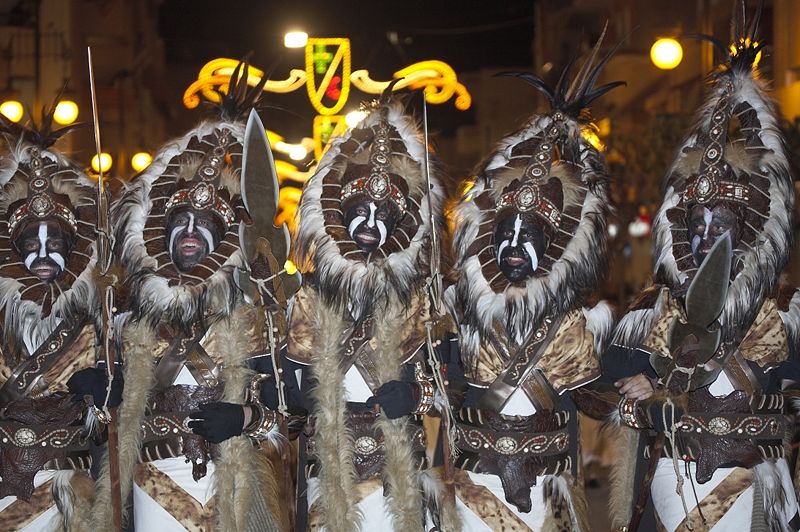
![[Smile]](smile.gif)
quote:Where is your evidence of a Berber tribe that wasn't described as black before the 15th century. I have been waiting for some months now.
Originally posted by the lioness:
quote:Libyan
Originally posted by alTakruri:

Faience tile from the royal palace at Medinet Habu.
Ramesses III ( 1186–1155 BC)
Cheikh Anta Diop said the Berbers were descendants of Sea people and also intermarrtied with Vandals. Kabyles tend to have that look.
Diop said ancient Egyptians were unrelated to Berbers.
![[Big Grin]](biggrin.gif)
![[Wink]](wink.gif)
quote:. "We are told of a woman returning from an oven with a pot, which she dropped thus attracting attention to herself. On noticing she was black, the Cordobans shouted ‘there is a black Berber’, and she was killed.”. p. 75 The Fall of the Caliphate of Cordoba: Berbers and Andalusis in Conflict.
Originally posted by the lioness:
Full text of
"Granada, Or, The Expulsion of the Moors from Spain"
George Cubitt 1878
http://www.archive.org/stream/granadaorexpuls00cubigoog/
.
quote:I think it also had something to do with what happened with the Almoravids got into power, but i can't remember. Would have to go back and look.
Originally posted by Djehuti:
^ So what do you make of this attack against Berbers? Do you think this was done by white natives against people who saw them as oppressors?
quote:hi jehosafats - have you long been a member here, and just now returning, because if so I can see why you left with all of the trolls about?
Originally posted by HERU:
jehosafats here
Don't forget the poor land allotments after the initial conquest of Iberia, which led to the Berber Revolt.
I figured it was well-known Berbers were widely discriminated against, especially in terms of housing and employment. They were mostly rural and did rather menial jobs. Also, the Caliph's Black Guard had a menacing presence in Cordoba.
quote:The Almovarids are described as Berbers
Originally posted by dana marniche:
quote:I think it also had something to do with what happened with the Almoravids got into power, but i can't remember. Would have to go back and look.
Originally posted by Djehuti:
^ So what do you make of this attack against Berbers? Do you think this was done by white natives against people who saw them as oppressors?
quote:http://books.google.com/books?id=m-Wvg__iHPAC&pg=PA103
Originally posted by dana marniche:
"We are told of a woman returning from an oven with a pot, which she dropped thus attracting attention to herself. On noticing she was black, the Cordobans shouted ‘there is a black Berber’, and she was killed.”.
p. 75 The Fall of the Caliphate of Cordoba: Berbers and Andalusis in Conflict.
[/QB]
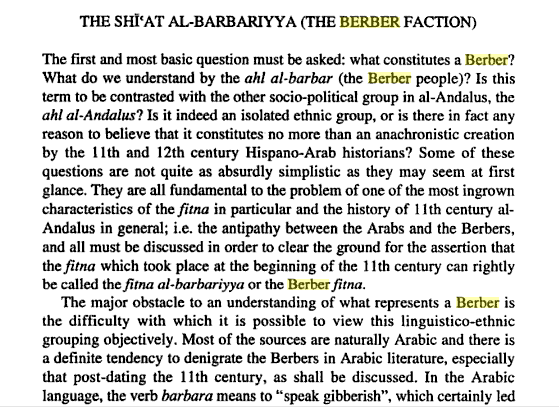
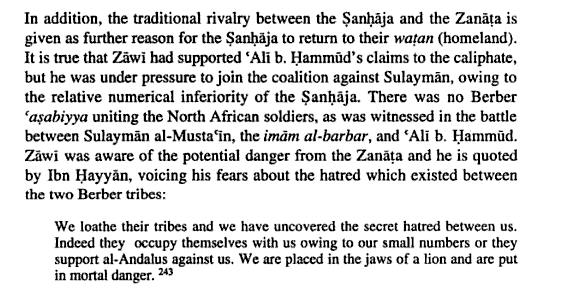
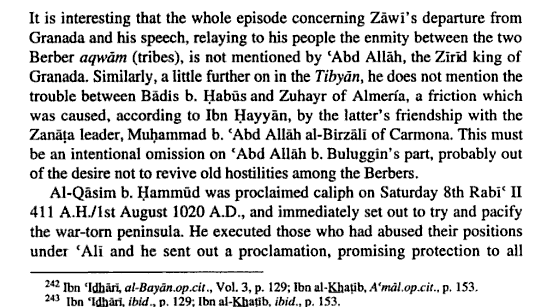
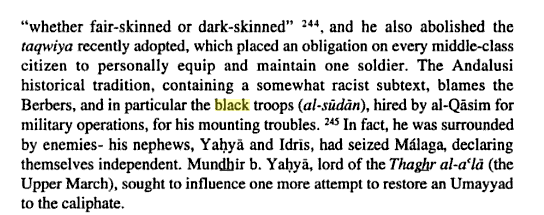
quote:I drop by from time to time. Ausur guided me here some years back. We used to talk Egyptology and African history in general on yahoo chat.
Originally posted by dana marniche:
hi jehosafats - have you long been a member here, and just now returning, because if so I can see why you left with all of the trolls about? [/QB]
quote:Yes we know Berbers were not the only black people in Iberia, Neanderdull. Blacks from the Sudan and Arabia can be included.
Originally posted by the lioness:
[QUOTE]Originally posted by dana marniche:
![[Smile]](smile.gif)
quote:And the Berbers were described as black in that period
Originally posted by the lioness:
quote:The Almovarids are described as Berbers
Originally posted by dana marniche:
quote:I think it also had something to do with what happened with the Almoravids got into power, but i can't remember. Would have to go back and look.
Originally posted by Djehuti:
^ So what do you make of this attack against Berbers? Do you think this was done by white natives against people who saw them as oppressors?
![[Big Grin]](biggrin.gif) as MOST of these Guddala and Lamtuna who were the Almoravids - still called Ilamtuna or Kel Aulammidden or Tuareg, still are.
as MOST of these Guddala and Lamtuna who were the Almoravids - still called Ilamtuna or Kel Aulammidden or Tuareg, still are. 
![[Wink]](wink.gif)
quote:All very interesting. But you imply here that Berber is synomous with Black. I do not bleieve that is true.
Originally posted by dana marniche:
I found out quite recently that Berbers and Andalusians, Kurds and Berbers in the Fatimid alliance, Greek Copts and Egyptian Copts in Egypt had a lot of same color problems and conflict that is found in modern times. Apparently these problems were similar or an earlier cycle of what's going on today - in Libya especially. Even the so-called Zanj revolt turned out to be a revolt of a mainly black Arabs and a minority of black Africans all free in Iraq.
The Berbers especially during Almoravid and Almohad periods had a rather intense racial problem and rivalry with the native Muslim Andalusis or rulers of the Spanish Muslims. It may not have started out racial, but as usual it ended up that way.
Here are a few examples from texts of what I am talking about.
Al Raqiq who was a servant of the North African Sanhaja Zirids wrote about the conflict in Cordoba. He "illustrates through anecdote this animosity but this time gives his story racial overtones. We are told of a woman returning from an oven with a pot, which she dropped thus attracting attention to herself. On noticing she was black, the Cordobans shouted ‘there is a black Berber’, and she was killed.”. p. 75 The Fall of the Caliphate of Cordoba: Berbers and Andalusis in Conflict.
Cordoba although a slave state was at that time "the most sophisticated city in Europe".
Beginning in the 10th century with the "half-Basque" blue eyed Abdul Rahman III there had been a growing population of Muslims among the ruling classes that were partly descended from white slaves yet had claimed Arab ethnicity. There was also a large Slavic population that were the former slaves of the Umayyads occupying the Levant region in Spain.
The earliest Arabian population however was from the Yemen and from other tribes that are noted as being black in the Arabian peninsula during that same period. As Thomas Arnold put it in his book, Legacy of Islam (published 1931), the slaves were mostly “from the Slavonic peoples”, and in Spain, Muslims “preferred the mothers of their children to be those fair-complexioned slaves captured in the north of Spain, rather than, or in addition to, their own womenfolk…” Persians and Turks were also called "the freedmen" by the Umayyads at this time.
By the time the Almoravids arrived in the 11th century many of the Muslims are already other than the original Moorish Masmuda/Zanata populations i.e. other than black.
At the turn of the 11th century an ibn Abi Amir had begun to import a large number of Berber mercenaries especially from the Sanhaja tribe that had already a developed disliked for the Umayyads. This ibn Abi Amir was continuing what Abd er Rahman had done.
The imported Berbers were "professional soldiers known for their horsemanship and outstanding courage" Abi Amir used them for military campaigns against the Christian Europeans of Navarr,e LEon and Castille.
Each year Ibn abi Amir "would return from these campaigns with many thousands of captives, male and female" pp. 41-42 (1992) Jayyusi and Marin "The Political History of al-Andalus" in The Legacy of Muslim Spain
The Sanhaja groups (derived from the Tuareg/Songhai populations) had taken over Cordoba and apparently many of the Hispano Muslims resented it. Anger had grown against these Berbers in their Cordoban capital called Madinat al- Zahra, and it came to the point where they had to be armed to be safe. Much of this anger came from the upper classes who actually may have been quite different from the plebeians who are given the derogatory names such as "sawad".
In any case " it is difficult to ascertain whether it was all the Cordobans, both the mob and the nobility that who hated the Berbers, as the sources are vague as to who exactly were the initiators of this animosity: 'they say hatred of the Berbers was made known'". p. 67 The Fall of the Caliphate
According to historian Peter C. Scales sometime in the 11th century
"The fitna in Cordoba between the people and the Berbers flared up... The mob was given free reign to attack the Berber tribes. It was presumably in this pogrom that Abd Al Malik al Muzaffar's old teacher Ahmad bin Abda'l Azziz bin Faraj Ibn al-Hubab, a grammarian had died. Ibn Bashkuwal tells us that he was a Berber of the Masmuda tribe. It would seem that the murder of North Africans encouraged by Muhammed al-Mahdi's request to be brought Berber heads was not restricted to the capital." p 70
Also Ibn abdal Jabbar "a Hispano Muslim ordered any who had a similar appearance to a Berber to be killed.” p. 74
"There are certainly 2 instances documented of innocent Maghrebis being caught up in the racial animousity where vented by the local populations in the south of al-Andalus. In Elvira a pilgrim from Ceuta, a certain Khalaf b. Ali b. Nasir b. Mansur al Balawi al Sabti, ..." p. 70
The name Balawi is always a reference to the Baliyy or Baliyyun of Idrisi tribe of the Himyarites occupying Hadramaut and Africa, so this person could have been either Arabian or Berber.
"Another Khalaf (b.Masud al Jarawi) a faqir from Melilla was murdered by the people of Malaga 'during the Andalusi revolt against the Berbers at the time of the al-Mahdi's uprising.'" Fall of the Caliphate of Cordoba
Thus a man of the Jarawa tribe (i.e. Garawan or Wangara) who were "a huge portion" of the Zanata Berbers in that period was killed. The Daza inhabitants of Fezzan and Germa are largely descended from Garawan and still call themselves Garan or Goran.
At one point Berbers were concentrated in a segregated section of Cordoba.
“The Berbers had been quartered in the palace of al-Zahra but were in fear of their lives if they went out alone.” p. 73
After having to flee this place, "The Berbers returned to al-Zahra to evacuate their families and belongings…".(p. 77) For “Muhammed (al-mahdi)solemnly swore to never rest until he had rid himself of all the Berbers. " p. 77
The Fall of the Caliphate of Cordoba
After these Almoravid Berbers got back in power under a Sulayman al Musta'in Andalusia was distributed to various Berber tribes.
The Sanhaja (Tuareg/Songhai) received Elvira (Grenada), the Maghrawa branch of the Zanata received areas north of Cordoba, the Banu Yafran/Ifren or (Ifuren Tuareg tribe) received Jaen. Other Zenata received other fiefs.
Another example of white Muslim racial insults against the Berbers is evidenced in the story of Al Ja'far or Gafar a poet who fell in love with the same woman the son of the Almohad ruler had a thing for.
Abu Ga'far was already involved in a conspiracy against the Berbers and their leaders which at that time were Abd'Al-Mumin a Zanata member of the mostly Masmuda Almohades dynasty and his son.
He had been working for Abd-al Mumin but the last straw was when he mockingly insulted Abdal-Mumin's son saying "What do you see in that black fellow? If you wish, I could buy you ten better ones in the slave market."
"Hearing that he was to be imprisoned the poet fled to Malaga" where he was not long afterwards executed.
Some people just can't be trusted.![[Wink]](wink.gif)
The idea that Berbers were of obviously different appearance from the Spaniards including their Spanish Muslim countrymen is born out by the documents.
quote:Oh boy here we go again.
Originally posted by Djehuti:
^ LOL Typical Lyinass strawman post which has NOTHING to do with what Dana is talking about!
More to the point. Modern day Spaniards portraying the Moors who once occupied them.
Interesting findings by the way, Dana. There's no way getting around it. The Moors looked different from the native Spaniards as well as Syrians and Iraqis. What could it be?...
Oh yeah, they're black.![[Smile]](smile.gif)
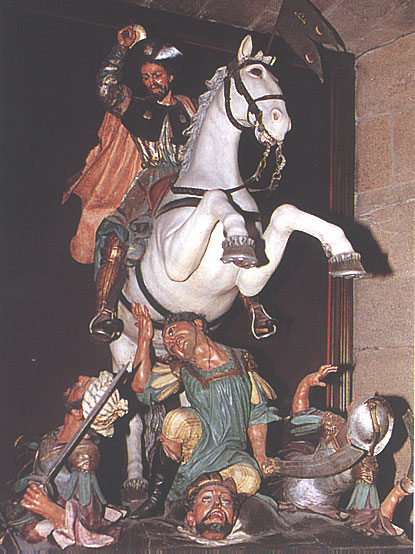
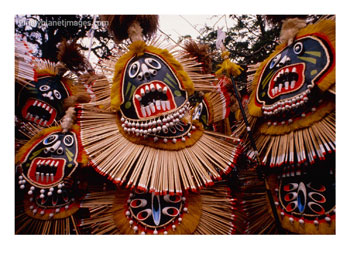
quote:'Berber' itself is not synonymous with black because it is a language group spoken by peoples of many complexions including 'white' peoples; however, that does no change the FACT that Moor is synonymous with black as that was its very meaning!
Originally posted by malcontent7:
All very interesting. But you imply here that Berber is synonymous with Black. I do not believe that is true.
quote:Yes, here we go with some valid evidence, and more of your b.s.
Oh boy here we go again.
quote:And are you sure these were actually Moors depicted or Saracens? You see during Moorish times, there were fair-skinned Saracens from Syria that were present in Europe as well. And although I can't find it at the moment, the same Spanish parade whose people portrayed Moors in black-face also portrayed Saracens by simply wearing turbans and robes. Again Moor means black. I know how much this irks you, but too bad.
Here are more folks dressing as Moors. Oops they ain't Black!
quote:Okay. And those people he tramples are slightly darker in complexion. And?
This is there here Santigo trampling the Moors.
quote:LOL The only one getting silly is YOU since you have no proper defense to Spaniards donning black-face to portray Moors!
And if you want to get silly. Here are the Black Moors right here.

![[Big Grin]](biggrin.gif)



![[Wink]](wink.gif)
quote:Why put words in my mouth. Why would Berber be a name synonymous with Black when Berber was a name for an ethnic group - unlike today in which it is used for a dialect and people who speak it.
Originally posted by melchior7:
quote:All very interesting. But you imply here that Berber is synomous with Black. I do not bleieve that is true.
Originally posted by dana marniche:
![[Big Grin]](biggrin.gif)
quote:Where does it say Santiago is trampling Moors? Just wondering, because they look like Andalusian Muslims to me.
Originally posted by Djehuti:
quote:
Originally posted by malcontent7:
[QUOTE][qb]This is there here Santigo trampling the Moors.
![[Big Grin]](biggrin.gif)
![[Smile]](smile.gif)


quote:I can't believe you would ask this question after all the similar paintings I have posted
Originally posted by dana marniche:
quote:Where does it say Santiago is trampling Moors? Just wondering, because they look like Andalusian Muslims to me.
Originally posted by Djehuti:
quote:
Originally posted by malcontent7:
[QUOTE][qb]This is there here Santigo trampling the Moors.
![[Big Grin]](biggrin.gif)
![[Smile]](smile.gif)
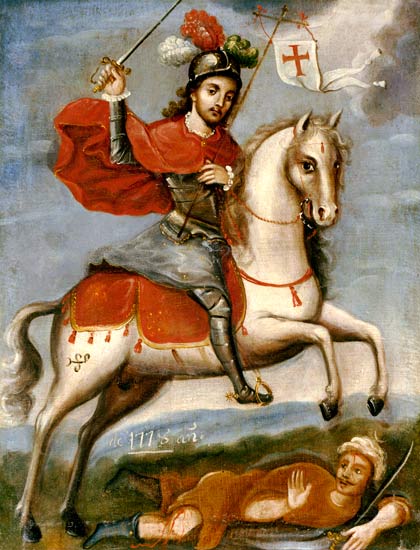

quote:
Originally posted by the lioness:
quote:_______________________THE MOORS_______________________
Originally posted by malibudusul:
The bloody Battle of El Puig, during the conquest of Valencia. Behind the king who pierces
with his spear the armor and breast of a Moor, there is Saint George fighting
and killing another Muslim with the sword.
http://www.studiolum.com/wang/jaume/jaume-i-9.jpg
Differences between the arms and tactics of the Moors and Christians. Altarpiece of St. George, Jérica, work of the circle of Marçal de Sax, c. 1420
http://www.studiolum.com/wang/jaume/jaume-i-10.jpg
http://riowang.blogspot.com.br/2010/11/i-did-not-say-that.html
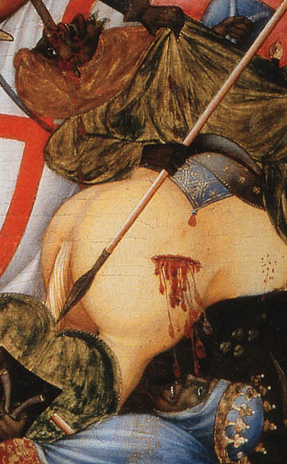


quote:
Originally posted by Djehuti:
^ There is obviously a confusion some folks have between Moors and Muslims. Not every Muslim in the Medieval Islamic world was a Moor and not all Moors were Muslims, though the vast majority who were in Europe at that time were.





quote:How about Sufism,certain dances like say Flamenco,Fractal Mathematics introduced there by Hugo of Santalla in twelfth century Spain,this also worked itself in geomancy
I challenge you to show me some remnant of a Black African cultural element or tradtion in Spain, or some Black African loan words in Spain from say Wolof or Bambara etc
quote:
Brada this thread is about Al-Andulus not convert employees of the Christians


quote:You people are really a trip. lol!. What I know is that you are definitely as block headed as your Neanderdull brethren. That's what I know. Are you telling me Berbers did not give anything to Moorish Spain.
Originally posted by melchior7:
[b]
As you can see the Moors were a mixed bunch with Blacks being among the minority.
Can you produce a depiction from midieval Spain that proves the contrary? I don't think you can.
And to Dana Marnich, I challenge you to show me some remnant of a Black African cultural element or tradtion in Spain, or some Black African loan words in Spain from say Wolof or Bambara etc. You can't becuase the Blacks that came to Spain were in the service Muslims, stripped of their culture and thoroughly islamicized. They adopted Arab langauge and culture. All their learning, technology and science came from the Arabs. Nothing Black African. And you know thats a fact. Thats why to claim that Blacks supposedly brought civilization to Europe or whatever rings empty!
![[Smile]](smile.gif)
![[Smile]](smile.gif)


quote:what is the page number in Golden Age of the Moors this appears. I suspect it is not made by a Mulsim artist or Iberian.
Originally posted by Brada-Anansi:
Loiness
quote:
Brada this thread is about Al-Andulus not convert employees of the Christians
Errr,,these were not converts,this was done by Iberian artist in 1400's Spain aka Iberia and they were not employees of Christians. goto Golden age Of The Moors.
BTW look how you zero in on the Moor on his knees before the anti-Christ but not the one sitting on his throne wearing a crown..ah tell gotta keep an eye on ya all the time.
quote:pages 38-40
what is the page number in Golden Age of the Moors this appears. I suspect it is not made by a Mulsim artist or Iberian. What do you mean "on his knees before the anti-Christ?" Who is the man kneeling before and why is he kneeling and what is the primary source of this illustration?



quote:
Also on page 37 immediately preceeding those illustrations is this statement: Brunson, Rashidi Golden Age of The Moor, ed. Ivan Vansertima

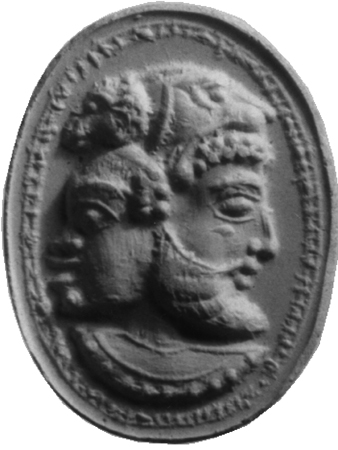
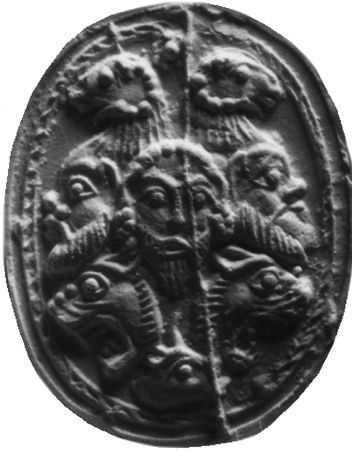
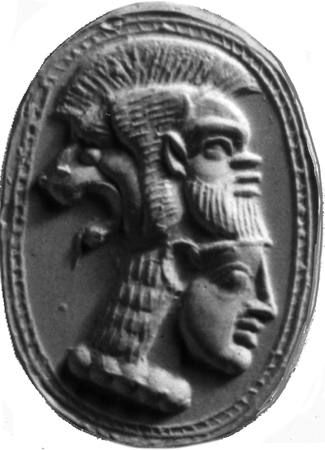
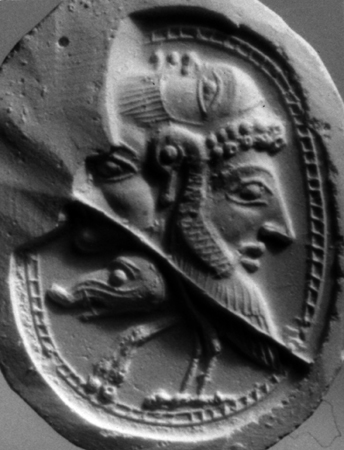

quote:
Originally posted by the lioness:
note dates, try not to post something from a later period like Orientalists of the 19th/20th cent
quote:
Originally posted by the lioness:
Santiago Matamoros. 17th century
Santiago Matamoros. 18th century [/QB]
quote:
Originally posted by -Just Call Me Jari-:
You realize how dumb you sound demanding that folks don't post stuff from later Centuries after the Moors were expelled(15th Century) yet post stuff from later periods.
I mean you realize this makes your argument bunk right.
[QUOTE]Originally posted by the lioness:
note dates, try not to post something from a later period like Orientalists of the 19th/20th cent. The Santiagos are 17th and 18c so I didn't violate
quote:I specified don't post 19th cent/20th century orientalists.
Originally posted by the lioness:
Santiago Matamoros. 17th century
Santiago Matamoros. 18th century
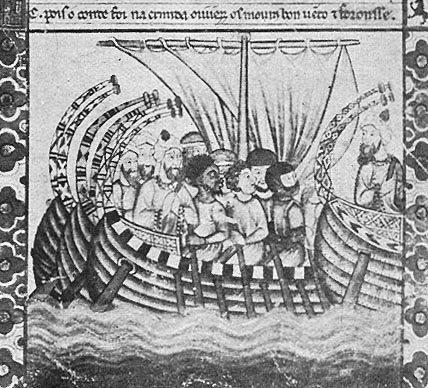
quote:In any case genetics as well as records clearly shows that there was diversity on both sides of the straits and broad featured Africans figured prominently on either side going back centuries before the Islamic era,they were not auxiliary or second class in their own story,the point of this thread is all hell broke loose when Iburo and Mesopotamian Muslims tried to do just that,
Brada. on page 3 right after pg 2 you put up Van Sertima discusses dana's view that the Moors were black and contrasts it with Wayne Chandler's chapter who believes they were quite mixed as did Brunson/Rashidi. The Golden Age of the Moor has different views coming from different authors of different chapters. I also heard Wayne dumped dana and she was mad. It might just be a rumor
quote:Your depiction of Blacks in hooded garments looks very interesting. But is propaganda and likely racist showing that “Blacks” are supporters of the antichrist. This does not tell what most of the Moors in Spain looked like. The Cantigas portrayed scenes from everyday life.
Originally posted by Brada-Anansi:

Dates from the 1400's
The term Moor predates Muslims, and it has always meant black we covered this time and again but Lioness like to keep rehashing old arguments and yes ,Djehuti every Black was a Moor but all Moors weren't Blacks especially by late medieval times, St Maurice for instance was a Moor but he was non Muslim and did not hail from North West Africa and below the Roman writer Martial inter change Moor with Ethiopians,so too did Juvenal
“Grieve not at this, poor wretch, and with thine own hand give thy wife the potion whatever is be for did she choose to bear her leaping children in her womb thou wouldst, perchance, become the sire of an Ethiop, a blackamoor would soon be your sole heir.”
- Juvenal, Satire VI, lines 596 – 600
“One of them, with wooly hair, like a Moor, seems to be the son of Santra, the cook. The second, with a flat nose and thick lips, is the image of Pannicus, the wrestler . . . of the two daughters, one is black . . . and belongs to Crotus, the flute player.”
Martial, VI, 39.
“When tired of each noblest matron, (Gildo) hands her over to the Moors. These Sidonian mothers, married in Carthage City, must needs be mate with barbarians. He thrusts upon me an Ethiopian son-in-law. This hideous hybrid affects the cradle.”
Claudian.
Read more: http://egyptsearchreloaded.proboards.com/index.cgi?board=bag&action=display&thread=25&page=3#ixzz1wqeojFyn
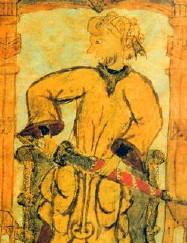


quote:While many will argue that Sufism has its origins in Egypt, the practice of Sama that of the whirling dervish comes out of Turkey. In any case Flamenco dancing can be traced back to Northern India where it originated with the Romani. There may be some Moorish Arabic influences however.
Originally posted by Brada-Anansi:
Melchoir7
quote:How about Sufism,certain dances like say Flamenco,Fractal Mathematics introduced there by Hugo of Santalla in twelfth century Spain,this also worked itself in geomancy
I challenge you to show me some remnant of a Black African cultural element or tradtion in Spain, or some Black African loan words in Spain from say Wolof or Bambara etc
http://www.youtube.com/watch?v=LXRvwk12atw
http://www.youtube.com/watch?v=6sAXdQP1RnM
Please clik the above
A non Islamic influence that was felt was that of the magician and may have influence European witch craft.
book a history of secret sociaties by arkon darul.the earliest mentions of the witches sabbats;which were also known as "synagogues" came in the eleventh century,and seem to show the assimilation of the diana cult with another:
one which involves the worship of a "black man". then we have mentions of brewing of potions,rubbing on oinyments,meetings and spells at cross-roads,renouncing christianity and the use of the wax image in a death-spell. by the fifteenth century,there was a remarkable similarity between witch meeting reported or confessed to,in many countries,some without much contact with one another. reference will be made later to the "sabbat" rituals reported from sweden,spain,scotland and france.
from the 7th~15th centuries the moors were ruling spain and north africa. cultral penetration from their universities into western europe was enormous; while their transltions of greek and other philosophical books posed a challenge which the theologians of the west were hard to meet during this very same period, a strange cult had arisen in morocco,crossed the strits into andaluisa, and wasactively-if secretly-followed in the centres of arab civilization with cosmopolitan populations. the latter consisted of arabized jews,christians scholors and wandering ascetics who travelled from one country to another in search of knowlage. the cult was called by the arab authorities{who tried to put it down} "the double horned", and it seemed to be connected moon-worship. it was certainly associated with magic, and its similarities to what were later reported as witch practises are very close.
the devotees of this cult met on thursday nights,were initiated by having a wound inflicted somewhere on their bodies{which left a smallscar},and beleived that they could raise magical power by dancing in or around a circle.
some of them claim that they at times carried out religious services which involved the saying of the moslem prayers backwards,and invoking el aswad(the black man)to help them. they served their priests, whom they saw only rarely, says the historian ibn jafar,after taking an oath of fealty of body and soul,they were drawn from all sections of the community, were of both sexes, and used ritual knives in the scarring ceremony. these knives were known as al-dhamme' or bloodletters. here is a typical initiation ceremony of the horned ones:we gathered by night, where two paths met and crossed; and he who had been so instructed bore with him a cock, which was to be sacrificed as the emblem of the new day. each carried a staff with two horns in brass upon the head; which is symbolical of the goat which is ridden,the sign of power and irresistiblity. "this meeting which is called the zabbat,the forceful or powerful one; and the circle of companions are the kafan(arabic for winding sheet).
we were thus termed, because each man wears over his naked flesh during the ritual only the white plain sheet in which he will be buried. "i was given the sanctity that night, and to join with the band of the elect who would spread joy throughout the world. those of us who are companions of the rabbna(our lord) examplified by the blacksmith".
in morocco to this day, blacksmiths are considered to be great sorcerers; and in the middle east in general(as well as in the arabian nights)it is the moor who is always the magician.
http://www.egyptsearch.com/forums/ultimatebb.cgi?ubb=get_topic;f=15;t=001044
Old post of mine.
quote:Let’s not start flinging insults so early in the game.
Originally posted by dana marniche:
You people are really a trip. lol!. What I know is that you are definitely as block headed as your Neanderdull brethren. That's what I know. Are you telling me Berbers did not give anything to Moorish Spain.
Here is one thing of many things for you to learn about the black people called Berbers. The word for horsmanship in Spain "Jinete" is derived from the Zenetes or Zanata Berbers i.e. Zaghawa or Azuwagha horsemen.
"Originally, it meant a type of light cavalryman, proficient at skirmishing and rapid maneuver."
They also brought the jousting and javelins into Iberia, probably much like what was happening in the region of Bornu among Zaghawa related peoples there.![[Smile]](smile.gif)
BTW - The sholarly i.e. non-Euronut sources on the Cantigas say they depict Muslims not necessarily Berbers and Arabs. in fact it is recognized they could be depicting people from anywhere in the Middle East.
So your Euronut site explanation is not going to work here.
The word Moor was a synonym for Negro among Mozarabs and I am just explaining why.![[Smile]](smile.gif)
Hydraulics of course is another wonderful introduction of the Africans whose ancestors were the "pitch black" Garamantes, Gamphasantes Ghadmusii, Tidamensii and other peoples who possessed complex systems of irrigation and hydraulics as early as 4000 years ago.
A foggara of Gourara a town of Central Algeria, where live Zanata berbers. The technology for Afro Berber irrigation practices dates back thousands of years.
You are pitiful. Why are you so jealous of these Africans.
They are descendants of the Ibadites and Kharijites pushed southwards by later Arab invaders from northern parts of eastern Maghreb.
![[Frown]](frown.gif) And you don’t know what race I am but if it means anything to you, I am not white. Let me start by saying that I find it interesting that you would think that a stretch of water eight miles wide between Spain and North Africa would act as such an effective racial barrier where you would have Whites and one side and Blacks on the other despite the archaeological and historical evidence which shows migrations gong back and forth from continent to continent over many millennia. I wonder where in the world you have seen such a racial divide where one race suddenly ends and another begins within a short geographical distance? Normally the case is that racial changes occur gradually over a fair amount of distance. This you see in North Africa when you go south from the coast line into the Sahara.
And you don’t know what race I am but if it means anything to you, I am not white. Let me start by saying that I find it interesting that you would think that a stretch of water eight miles wide between Spain and North Africa would act as such an effective racial barrier where you would have Whites and one side and Blacks on the other despite the archaeological and historical evidence which shows migrations gong back and forth from continent to continent over many millennia. I wonder where in the world you have seen such a racial divide where one race suddenly ends and another begins within a short geographical distance? Normally the case is that racial changes occur gradually over a fair amount of distance. This you see in North Africa when you go south from the coast line into the Sahara.![[Wink]](wink.gif)
quote:Well Michloir your original question was African influence on Islamic Spain so that was my answer,but what did Islamic science and technology
While many will argue that Sufism has its origins in Egypt, the practice of Sama that of the whirling dervish comes out of Turkey. In any case Flamenco dancing can be traced back to Northern India where it originated with the Romani. There may be some Moorish Arabic influences however. The reference about the witchcraft practice from North Africa is a good one. I had read about that before. I don’t doubt that there was some influence probably in Southern Spain. Historically however there are not a lot of records of witchcraft trial in Spain as compared to other European countries. The majority were in the Basque regions and reflect a lot of Basque derived superstition and folklore.
quote:Thats only if you believe that most Egyptians were BLack. The ones in upper Egypt were mostly Balck. But not those in lower Egypt. Its good to have some pride in your race. But one should be careful not to take it too far. Objectivity and truth is always best, my friend.
Originally posted by Brada-Anansi:
Michloir7
quote:Well Michloir your original question was African influence on Islamic Spain so that was my answer,but what did Islamic science and technology
While many will argue that Sufism has its origins in Egypt, the practice of Sama that of the whirling dervish comes out of Turkey. In any case Flamenco dancing can be traced back to Northern India where it originated with the Romani. There may be some Moorish Arabic influences however. The reference about the witchcraft practice from North Africa is a good one. I had read about that before. I don’t doubt that there was some influence probably in Southern Spain. Historically however there are not a lot of records of witchcraft trial in Spain as compared to other European countries. The majority were in the Basque regions and reflect a lot of Basque derived superstition and folklore.
consist of in the first place!! Old Nile valley schools of thought most of the time filtered through Greek records plus Persian and other Mesopotamian influences but the point about African fractals was one of direct influence, today secret societies such as the Masons still make use of Kemetic,Islamic and Levantine concepts and paraphernalia,I cannot independently verify that Alchemy etymologically means of the blacks as in Kem=black in Mdu Ntr and the Arabic Al means the,And what was Alchemy but burning things over a fire in a flask to blacken it,hence Alchemy is the science of the Blacks Ie the Kemities AkA the Egyptians.
![[Smile]](smile.gif)
quote:
Originally posted by the lioness:
quote:
Originally posted by -Just Call Me Jari-:
You realize how dumb you sound demanding that folks don't post stuff from later Centuries after the Moors were expelled(15th Century) yet post stuff from later periods.
I mean you realize this makes your argument bunk right.
[QUOTE]Originally posted by the lioness:
note dates, try not to post something from a later period like Orientalists of the 19th/20th cent. The Santiagos are 17th and 18c so I didn't violate
quote:I specified don't post 19th cent/20th century orientalists.
Originally posted by the lioness:
Santiago Matamoros. 17th century
Santiago Matamoros. 18th century
I could go dig up the much older 13th c Alphonso X stuff depicting Moorish Almohad Berbers but we've already done many extensive threads on this

quote:
"There is now a sufficient body of evidence from modern studies of skeletal remains to indicate that the ancient Egyptians, especially southern Egyptians, exhibited physical characteristics that are within the range of variation for ancient and modern indigenous peoples of the Sahara and tropical Africa.. In general, the inhabitants of Upper Egypt and Nubia had the greatest biological affinity to people of the Sahara and more southerly areas." (Nancy C. Lovell, " Egyptians, physical anthropology of," in Encyclopedia of the Archaeology of Ancient Egypt, ed. Kathryn A. Bard and Steven Blake Shubert, ( London and New York: Routledge, 1999) pp 328-332)
quote:
Originally posted by melchior7:
The ones in upper Egypt were mostly Balck. But not those in lower Egypt.
![[Smile]](smile.gif)
quote:I really don't want to get into this sh!t again. But let me ask you, if Blacks lived all the way up to the Delta region then what was the geographic limit for Blacks, and where did Middle Eatern types begin? Also why was it a limit?
Originally posted by -Just Call Me Jari-:
Other than pockets of Foreign migrants in later Times, you have proof to back up your claim that "Lower Egyptians were not Black" as opposed that Upper Egyptians were "Mostly" blacks
quote:
"There is now a sufficient body of evidence from modern studies of skeletal remains to indicate that the ancient Egyptians, especially southern Egyptians, exhibited physical characteristics that are within the range of variation for ancient and modern indigenous peoples of the Sahara and tropical Africa.. In general, the inhabitants of Upper Egypt and Nubia had the greatest biological affinity to people of the Sahara and more southerly areas." (Nancy C. Lovell, " Egyptians, physical anthropology of," in Encyclopedia of the Archaeology of Ancient Egypt, ed. Kathryn A. Bard and Steven Blake Shubert, ( London and New York: Routledge, 1999) pp 328-332)quote:
Originally posted by melchior7:
The ones in upper Egypt were mostly Balck. But not those in lower Egypt.
![[Smile]](smile.gif)
quote:Who said there was any geographic limits for Blacks, Blacks live all way out in the pacific the ancients certainly did not believe that,nor do genetics and again Kemet for most of it's history was oriented towards inner Africa,only with the arrival of powerful states did they even bothered taking the Med and beyond seriously,namely the Hyksos and the Hittites at first.
But let me ask you, if Blacks lived all the way up to the Delta region then what was the geographic limit for Blacks, and where did Middle Eatern types begin? Also why as it a limit?

quote:There were early neolithic populations in the Delta area early on.
Originally posted by Brada-Anansi:
Melchior
quote:Who said there was any geographic limits for Blacks, Blacks live all way out in the pacific the ancients certainly did not believe that,nor do genetics and again Kemet for most of it's history was oriented towards inner Africa,only with the arrival of powerful states did they even bothered taking the Med and beyond seriously,namely the Hyksos and the Hittites at first.
But let me ask you, if Blacks lived all the way up to the Delta region then what was the geographic limit for Blacks, and where did Middle Eatern types begin? Also why as it a limit?
quote:Yeah but Middle Eastern/Eurasian peoples have to start somewhere. If you notice most of the Blacks found in Asia are in tropical areas.
Originally posted by Brada-Anansi:
My point was Melchoir that if Blacks were found all the way out into the Pacific then Blacks found nearer to Africa should surprise no one after all the Natufians are linked to the Mashubians who came from the Nile Valley.
quote:And let's not forget that before the Natufians, there were the Kebarans centuries before who are also linked to a North African people called the Halfans. You also have early Arabian cultures like the Sabir which are linked to the Gash culture of the Horn and earlier culures linked with Doian culture of the Horn as cited by Dana. All of this is supported genetically not only by E1b1b in the Levant and Arabia but also far older E2. Also there are R1* lineages present whom Euronuts like Malcontent associate its presence in Africa to be a result of a back-migration though the ones in Africa are just as old if not older and more diverse.
Originally posted by Brada-Anansi:
My point was Melchoir that if Blacks were found all the way out into the Pacific then Blacks found nearer to Africa should surprise no one after all the Natufians are linked to the Mashubians who came from the Nile Valley.
quote:I can't believe you would even question pre islamic back migrations. Is it the New Afrocentric theory now that no back migrations into North Africa ever took place? I guess I've been away too long. I guess genetics is bogus too.
Originally posted by Djehuti:
^ You keep repeating that there were back-migrations. The only significant back-migrations we know of only occurred during Islamic times unless you have proof--valid and uncontested proof-- of back-migrations before this.
As Brada has told you there was NO "limit" for blacks as per evidence of the multiple waves of emmigrations outside of Africa both into Southwest Asia as well as into Europe!! As for 'Middle Eastern' types, the 'Middle East' is a geo-political term of Europeans. If by Middle East you mean Southwest Asia, then there were multiple and diverse types due to its location as a crossroads with some types resembling Africans right next door while other types resembling colder-adapted Eurasian types. The latter which you are no doubt referring to when it comes to the stereotypical light-skinned Middle Easterners quite naturally first appeared in the northern most areas of the 'Middle East' and likely originated from Central Asia, the Caucasus, etc.








quote:Kel Aulammiden Tuareg i.e Lamtuna are from Senegal and Mali dimwit. They brought their vassals which were the Songhai (who are their blacksmiths, craftsmen and musicians, etc).
Originally posted by melchior7:
quote:Your depiction of Blacks in hooded garments looks very interesting. But is propaganda and likely racist showing that “Blacks” are supporters of the antichrist. This does not tell what most of the Moors in Spain looked like. The Cantigas portrayed scenes from everyday life.
Originally posted by Brada-Anansi:

Dates from the 1400's
The term Moor predates Muslims, and it has always meant black we covered this time and again but Lioness like to keep rehashing old arguments and yes ,Djehuti every Black was a Moor but all Moors weren't Blacks especially by late medieval times, St Maurice for instance was a Moor but he was non Muslim and did not hail from North West Africa and below the Roman writer Martial inter change Moor with Ethiopians,so too did Juvenal
“Grieve not at this, poor wretch, and with thine own hand give thy wife the potion whatever is be for did she choose to bear her leaping children in her womb thou wouldst, perchance, become the sire of an Ethiop, a blackamoor would soon be your sole heir.”
- Juvenal, Satire VI, lines 596 – 600
“One of them, with wooly hair, like a Moor, seems to be the son of Santra, the cook. The second, with a flat nose and thick lips, is the image of Pannicus, the wrestler . . . of the two daughters, one is black . . . and belongs to Crotus, the flute player.”
Martial, VI, 39.
“When tired of each noblest matron, (Gildo) hands her over to the Moors. These Sidonian mothers, married in Carthage City, must needs be mate with barbarians. He thrusts upon me an Ethiopian son-in-law. This hideous hybrid affects the cradle.”
Claudian.
Read more: http://egyptsearchreloaded.proboards.com/index.cgi?board=bag&action=display&thread=25&page=3#ixzz1wqeojFyn
Again they were initially called Moros in Spain because of where they came from ( Mauretania) not because of what they looked like. Most the Berbers who crossed over into Spain were light skinned. Tarik himself was described as having red hair and an early depiction shows him to be simply a tawny Berber.
Other Europeans may have associated the word Moor for Black but they really didn’t have the concept of race as we do today. Moor just referred to swarthy people coming from the other side of the Mediterranean. When the Spanish invented the term Negro, the English and others followed suit and a clear racial distinction was made..
You may be familiar with the color ranking of the Roman Manilius. It shows that among dark peoples the mauritanians were the lighest.
In Manilius' order swarthy complexions from the most
dark to the least dark are
- Aethiopes
- India
- Aegyptia
- Afrorum
- Mauretania
This would seem to be in accordance with the majority of light brown folk we see in North Africa today.
Most Blacks brought to Spain came with the Almoravids. They were not North Africans but recruited form Senegal and Mali. It’s documented.
“Yusuf ibn Tashfin , second Almoravid leader and man destined to conquer Andalus, reorganised these armies. Original Almoravid forces had been a tribal confederation, but yusuf changed the command structure and created a personal force of black slaves and foreigners. His bodyguard consisted of 500 non-Berber horsemen, including Arabs, Turks and Europeans, supported by a further 2,000 black African cavalry. Christian mercenaries as well as converted Spanish prisoners continued to fight for the Almoravids and their successors both in Andalus and North Africa throughout the late 11th and 12th centuries.
Cavalry also became more important than camel-mounted troops, particularly when operating in Andalus. There the high number of black Africans in Almoravid armies, many recruited from Senegal on the southern frontier of the empire, had a terrifying effect on Christian morale- as did the use of massed drums, unusual forms of bow, enormously long leather shields, bamboo spears and other unfamiliar weapons. A continuing use of large number camels also unsettled the Spaniards’ horses, in fact, such animals had been known in southern Andalus since at least the 10th century.”
http://www.oocities.org/ihusselbee/crusader/moors2.htm
![[Big Grin]](biggrin.gif)
![[Big Grin]](biggrin.gif)
quote:First of all, I don't question that back-migrations took place at all during pre-Islamic times since it is well documented by pharaonic Egyptians themselves that foreigners settled around the Delta! What I question are the claims that some major back-migration took place during prehistoric times that led to the formation of preydynastic Egyptian populations! Again, there is just no evidence for it unless you can present any! In fact all the evidence points to the other way around-- waves of migration from Africa into the so-called Near-East!
Originally posted by malcontent7:
I can't believe you would even question pre-islamic back migrations. Is it the New Afrocentric theory now that no back migrations into North Africa ever took place? I guess I've been away too long. I guess genetics is bogus too.
quote:As to how far cold-adapted Eurasians reached into Arabia, I don't know. You'll have to ask Dana about that as she is the resident expert on Arabian history and archaeology. All I know is that Arab oral history itself speaks of foreigners who came in from the north and mixed with the natives, assimilating the language and culture of the natives while influencing the language and culture themselves. I myself am more knowledgeable about Egypt and I am well aware of what you firmly believe in regards to prehistoric North Africa, yet what you believe does not square up with the evidence at all! The predynastic Egyptians were a fusion of different peoples but they were ALL indigenous tropical Africans! I don't know what you base your beliefs on, but it is obviously erroneous.
You say Eurasians orginated in the Central Asia. Now that's a good start. Obviously they eventually made their way down into the Arabian peninsula, no? So here is another way to ask the question, how far south did these Eurasian types extend during the early days of the Egyptian kingdom??? As you can probably guess, I firmly believe they extended well into North Africa along the coastal areas, and that the Egyptians were a fusion of tropical Africans and these people. Hell even the Badarians seemed to have been mixed.
quote:LOL That old Strouhal study is outdated, as it was debunked by more valid assessments by his peers, which is something we've discussed many times over in this forum.
"By the individual analysis of nasal measurements and indices of the first Badarian series in comparison with the mixed Europoid-Negroid series from Wadi Qitna in Nubia (fourth-fifth century AD), with the Europoid series from Manfalout in Upper Egypt (Ptolemaic period) and with a series of recent Nilotes, I came to the conclusion that the distribution of the Badarian skulls extends from the Europoid to the Negroid range."
"Of the total 117 skulls, 15 were found to be markedly Europoid, 9 of these were of the gracile Mediterranean type, 6 were of very robust structure reminiscent of the North African Cromagnon type. Eight skulls were clearly Negroid... We may conclude that the share of both components was nearly the same, with some overweight to the Europoid side."
"In some of the Badarian crania hair was preserved, thanks to good conditions in the desert sand. In the first series, according to the descriptions of the excavators, they were curly in 6 cases, wavy in 33 cases and straight in 10 cases. They were black in 16 samples, dark brown in 11, brown in 12, light brown in 1 and grey in 11 cases."
Eugen Strouhal,The Journal of African History, Vol. 12, No. 1. (1971),
Say what you want be these folks showed admixture.
![[Big Grin]](biggrin.gif)
quote:Didn't you post this picture before last year or so only to have it refuted as NOT a Medieval portrait but a picture made in MODERN times by someone out of pure imagination??
Originally posted by malcontent7:
Again they were initially called Moros in Spain because of where they came from ( Mauretania) not because of what they looked like. Most the Berbers who crossed over into Spain were light skinned. Tarik himself was described as having red hair and an early depiction shows him to be simply a tawny Berber.

![[Big Grin]](biggrin.gif) is really due to Eurasian admixture from back migrations going back many of thousands of years. Most Berbers prior to the Moorish invasion were also greatly mixed with Eurasians. You can either be objective and acccept this or continue with your make-believin'...
is really due to Eurasian admixture from back migrations going back many of thousands of years. Most Berbers prior to the Moorish invasion were also greatly mixed with Eurasians. You can either be objective and acccept this or continue with your make-believin'... ![[Cool]](cool.gif)
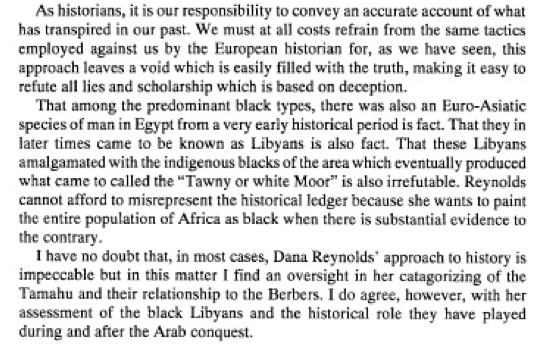
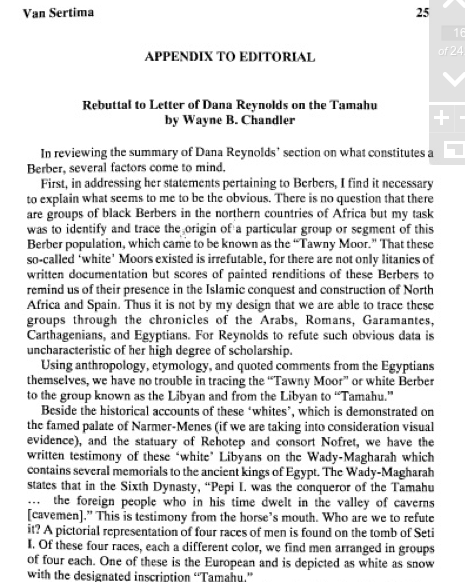
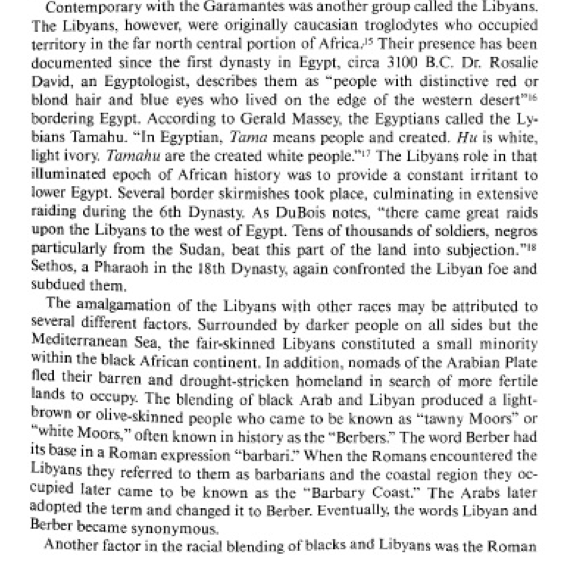
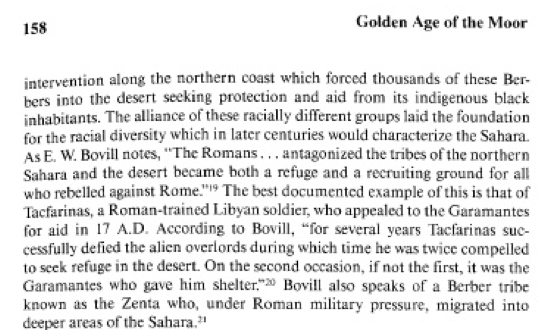

quote:In other words, you have no evidence to support your claims of ancient or prehistoric "Eurasian" or "Caucasian" presence in North and East Africa except the fact that some skulls have narrow features. Again, if you knew anything about bio-anthropology you would know that stereotypes about facial features have long been debunked and there is no need to explain such features as being due to Eurasians or Caucasians.
Originally posted by malcontent7:
I have to say I disagree with many of your responses. I don't know that arguing with you for any length of time will change your minds as you are fervently committed to your beliefs for various reasons. I will say this however, the earliest Africans were Khoisans and Pygmy types carrying haplogroup A and B. We know that they were the earliest inhabitant in East Africa especially Ethiopia. I am pretty sure the current phenotypical "diversity" in Ethiopia and certain other parts of East Africa..you know with regard to "Caucasian features" which y'all claim resulted from the natural adaptation to their environment..is really due to Eurasian admixture from back migrations going back many of thousands of years. Most Berbers prior to the Moorish invasion were also greatly mixed with Eurasians. You can either be objective and acccept this or continue with your make-believin'...
I'm outta here. Peace.![[Cool]](cool.gif)
quote:We are talking about the Dynastic Population here, and are you saying that there were no blacks/Dark Skinned populations in Prehistoric Asia?? Evidence???
Originally posted by melchior7:
[QB] and where did Middle Eatern types begin? Also why was it a limit?
Likely if Blacks reached up to the Mediterranean coast then they would have spilled over into Europe and the Middle East, or else it was Eurasians who spilled over into North Africa. I think the evidence supports the later scenario.
quote:Last I checked the Egyptians portrayed themselves with similar Skintones as the Nubians countless times, but considering you are a google scholar you would not know this.
Originally posted by melchior7:Why did the Egyptians portray themselves as lighter than the Nubians to the south?
quote:You have evidence that "Fine Features and Straight Hair" are not naturally found in Tropical Africans, if so please provide evidence.
Originally posted by melchior7:Why would they be lighter if Egypt is hot as hell? Why do so many Egyptians mummies have fine features and striaght or wavy hair?
With Haplogroups R and T found in Egytians, how can anyone deny that a good part of their genetic make up reflects a back to Africa migration from West Asia?
quote:So who exactly were those "europoid"? lol
Originally posted by melchior7:
quote:I can't believe you would even question pre islamic back migrations. Is it the New Afrocentric theory now that no back migrations into North Africa ever took place? I guess I've been away too long. I guess genetics is bogus too.
Originally posted by Djehuti:
^ You keep repeating that there were back-migrations. The only significant back-migrations we know of only occurred during Islamic times unless you have proof--valid and uncontested proof-- of back-migrations before this.
As Brada has told you there was NO "limit" for blacks as per evidence of the multiple waves of emmigrations outside of Africa both into Southwest Asia as well as into Europe!! As for 'Middle Eastern' types, the 'Middle East' is a geo-political term of Europeans. If by Middle East you mean Southwest Asia, then there were multiple and diverse types due to its location as a crossroads with some types resembling Africans right next door while other types resembling colder-adapted Eurasian types. The latter which you are no doubt referring to when it comes to the stereotypical light-skinned Middle Easterners quite naturally first appeared in the northern most areas of the 'Middle East' and likely originated from Central Asia, the Caucasus, etc.
You say Eurasians orginated in the Central Asia. Now that's a good start. Obviously they eventually made their way down into the Arabian peninsula, no? So here is another way to ask the question, how far south did these Eurasian types extend during the early days of the Egyptian kingdom??? As you can probably guess, I firmly believe they extended well into North Africa along the coastal areas, and that the Egyptians were a fusion of tropical Africans and these people. Hell even the Badarians seemed to have been mixed.
"By the individual analysis of nasal measurements and indices of the first Badarian series in comparison with the mixed Europoid-Negroid series from Wadi Qitna in Nubia (fourth-fifth century AD), with the Europoid series from Manfalout in Upper Egypt (Ptolemaic period) and with a series of recent Nilotes, I came to the conclusion that the distribution of the Badarian skulls extends from the Europoid to the Negroid range."
"Of the total 117 skulls, 15 were found to be markedly Europoid, 9 of these were of the gracile Mediterranean type, 6 were of very robust structure reminiscent of the North African Cromagnon type. Eight skulls were clearly Negroid... We may conclude that the share of both components was nearly the same, with some overweight to the Europoid side."
"In some of the Badarian crania hair was preserved, thanks to good conditions in the desert sand. In the first series, according to the descriptions of the excavators, they were curly in 6 cases, wavy in 33 cases and straight in 10 cases. They were black in 16 samples, dark brown in 11, brown in 12, light brown in 1 and grey in 11 cases."
Eugen Strouhal,The Journal of African History, Vol. 12, No. 1. (1971),
Say what you want be these folks showed admixture.



quote:Population continuity or population change: Formation of the ancient Egyptian state
Stature and the pattern of body proportions were investigated in a series of six time-successive Egyptian populations in order to investigate the biological effects on human growth of the development and intensification of agriculture, and the formation of state-level social organization. Univariate analyses of variance were performed to assess differences between the sexes and among various time periods. Significant differences were found both in stature and in raw long bone length measurements between the early semipastoral population and the later intensive agricultural population. The size differences were greater in males than in females. This disparity is suggested to be due to greater male response to poor nutrition in the earlier populations, and with the increasing development of social hierarchy, males were being provisioned preferentially over females. Little change in body shape was found through time, suggesting that all body segments were varying in size in response to environmental and social conditions. The change found in body plan is suggested to be the result of the later groups having a more tropical (Nilotic) form than the preceding populations. Am J Phys Anthropol, 2003.
quote:An Examination of Nubian and Egyptian biological distances: Support for biological diffusion or in situ development?
The origins of the ancient Egyptian state and its formation have received much attention through analysis of mortuary contexts, skeletal material, and trade. Genetic diversity was analyzed by studying craniometric variation within a series of six time-successive Egyptian populations in order to investigate the evidence for migration over the period of the development of social hierarchy and the Egyptian state. Craniometric variation, based upon 16 measurements, was assessed through principal components analysis, discriminant function analysis, and Mahalanobis D2 matrix computation. Spatial and temporal relationships were assessed by Mantel and Partial Mantel tests. The results indicate overall population continuity over the Predynastic and early Dynastic, and high levels of genetic heterogeneity, thereby suggesting that state formation occurred as a mainly indigenous process. Nevertheless, significant differences were found in morphology between both geographically-pooled and cemetery-specific temporal groups, indicating that some migration occurred along the Egyptian Nile Valley over the periods studied. Am J Phys Anthropol, 2007.
quote:The nubian mesolithic: A consideration of the Wadi Halfa remains
"The clustering of the Nubian and Egyptian samples together supports this paper's hypothesis and demonstrates that there may be a close relationship between the two populations. This relationship is consistent with Berry and Berry (1972), among others, who noted a similarity between Nubians and Egyptians. If Nubians and Egyptians were not biologically similar, one would expect the scores to separately cluster by population (e.g. Nubians compared to Nubians would have small biological distances, and Nubians compared to Egyptians would have high biological distances). However, this was not the case in the current analysis and the Results suggest homogeneity between the two populations."
quote:"....inhabitants of East Africa right on the equator have appreciably longer, narrower, and higher noses than people in the Congo at the same latitude. A former generation of anthropologists used to explain this paradox by invoking an invasion by an itinerant "white" population from the Mediterranean area, although this solution raised more problems than it solved since the East Africans in question include some of the blackest people in the world with characteristically wooly hair and a body build unique among the world's populations for its extreme linearity and height.... The relatively long noses of East Africa become explicable then when one realizes that much of the area is extremely dry for parts of the year." (C. Loring Brace, "Nonracial Approach Towards Human Diversity," cited in The Concept of Race, Edited by Ashley Montagu, The Free Press, 1980, pp. 135-136, 138)
Morphological variation of the skeletal remains of ancient Nubia has been traditionally explained as a product of multiple migrations into the Nile Valley. In contrast, various researchers have noted a continuity in craniofacial variation from Mesolithic through Neolithic times. This apparent continuity could be explained by in situ cultural evolution producing shifts in selective pressures which may act on teeth, the facial complex, and the cranial vault.
A series of 13 Mesolithic skulls from Wadi Halfa, Sudan, are compared to Nubian Neolithic remains by means of extended canonical analysis. Results support recent research which suggests consistent trends of facial reduction and cranial vault expansion from Mesolithic through Neolithic times.


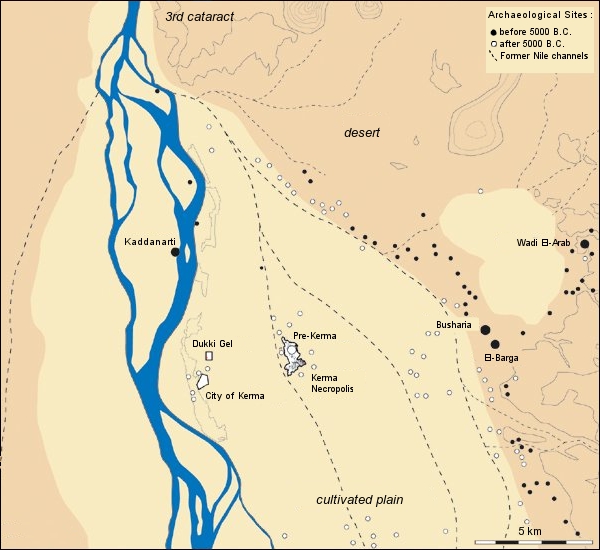

quote:Yale Egyptological Institute in Egypt
Originally posted by melchior7:
quote:I can't believe you would even question pre islamic back migrations. Is it the New Afrocentric theory now that no back migrations into North Africa ever took place? I guess I've been away too long. I guess genetics is bogus too.
Originally posted by Djehuti:
^ You keep repeating that there were back-migrations. The only significant back-migrations we know of only occurred during Islamic times unless you have proof--valid and uncontested proof-- of back-migrations before this.
As Brada has told you there was NO "limit" for blacks as per evidence of the multiple waves of emmigrations outside of Africa both into Southwest Asia as well as into Europe!! As for 'Middle Eastern' types, the 'Middle East' is a geo-political term of Europeans. If by Middle East you mean Southwest Asia, then there were multiple and diverse types due to its location as a crossroads with some types resembling Africans right next door while other types resembling colder-adapted Eurasian types. The latter which you are no doubt referring to when it comes to the stereotypical light-skinned Middle Easterners quite naturally first appeared in the northern most areas of the 'Middle East' and likely originated from Central Asia, the Caucasus, etc.
You say Eurasians orginated in the Central Asia. Now that's a good start. Obviously they eventually made their way down into the Arabian peninsula, no? So here is another way to ask the question, how far south did these Eurasian types extend during the early days of the Egyptian kingdom??? As you can probably guess, I firmly believe they extended well into North Africa along the coastal areas, and that the Egyptians were a fusion of tropical Africans and these people. Hell even the Badarians seemed to have been mixed.
"By the individual analysis of nasal measurements and indices of the first Badarian series in comparison with the mixed Europoid-Negroid series from Wadi Qitna in Nubia (fourth-fifth century AD), with the Europoid series from Manfalout in Upper Egypt (Ptolemaic period) and with a series of recent Nilotes, I came to the conclusion that the distribution of the Badarian skulls extends from the Europoid to the Negroid range."
"Of the total 117 skulls, 15 were found to be markedly Europoid, 9 of these were of the gracile Mediterranean type, 6 were of very robust structure reminiscent of the North African Cromagnon type. Eight skulls were clearly Negroid... We may conclude that the share of both components was nearly the same, with some overweight to the Europoid side."
"In some of the Badarian crania hair was preserved, thanks to good conditions in the desert sand. In the first series, according to the descriptions of the excavators, they were curly in 6 cases, wavy in 33 cases and straight in 10 cases. They were black in 16 samples, dark brown in 11, brown in 12, light brown in 1 and grey in 11 cases."
Eugen Strouhal,The Journal of African History, Vol. 12, No. 1. (1971),
Say what you want be these folks showed admixture.
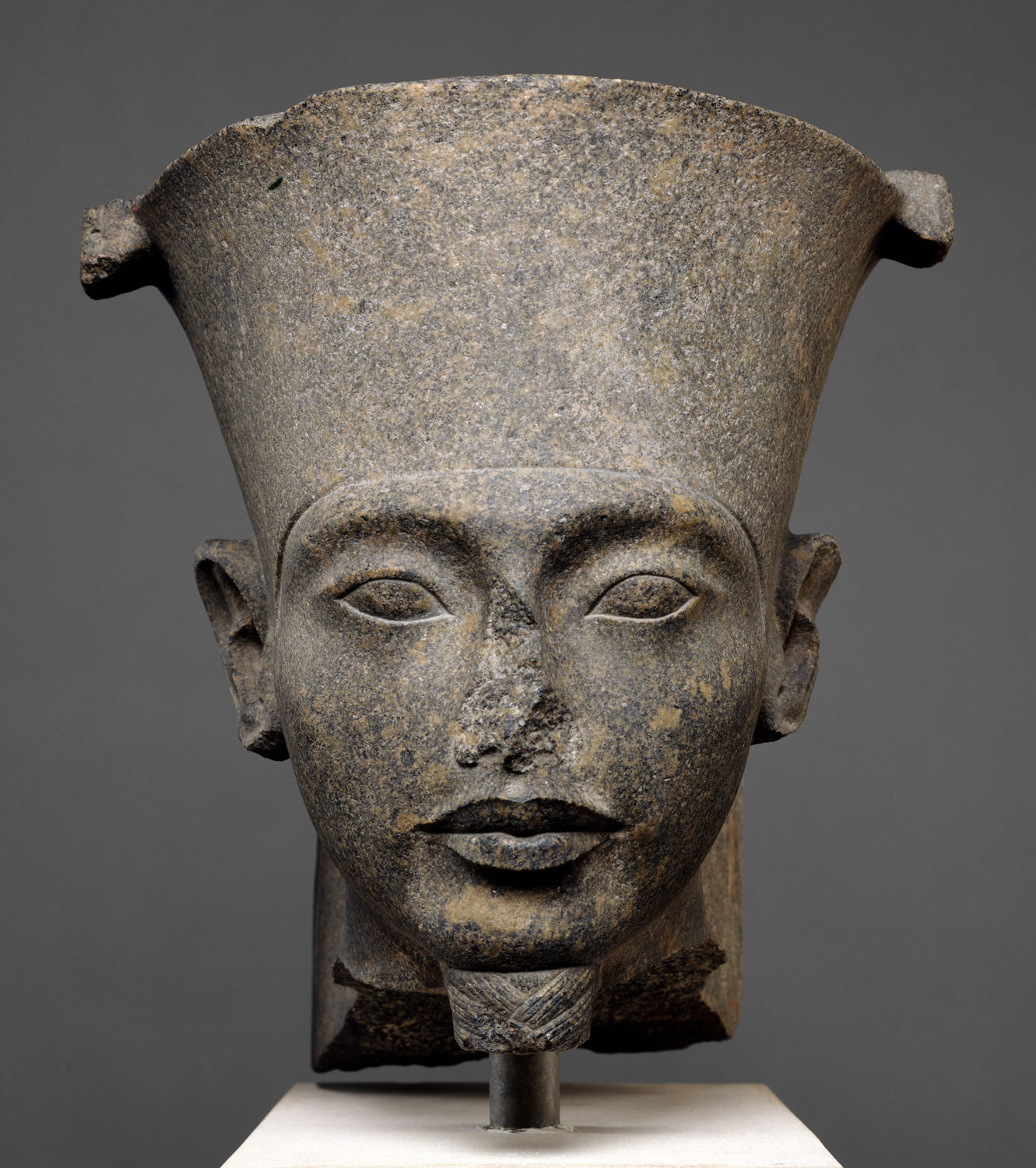
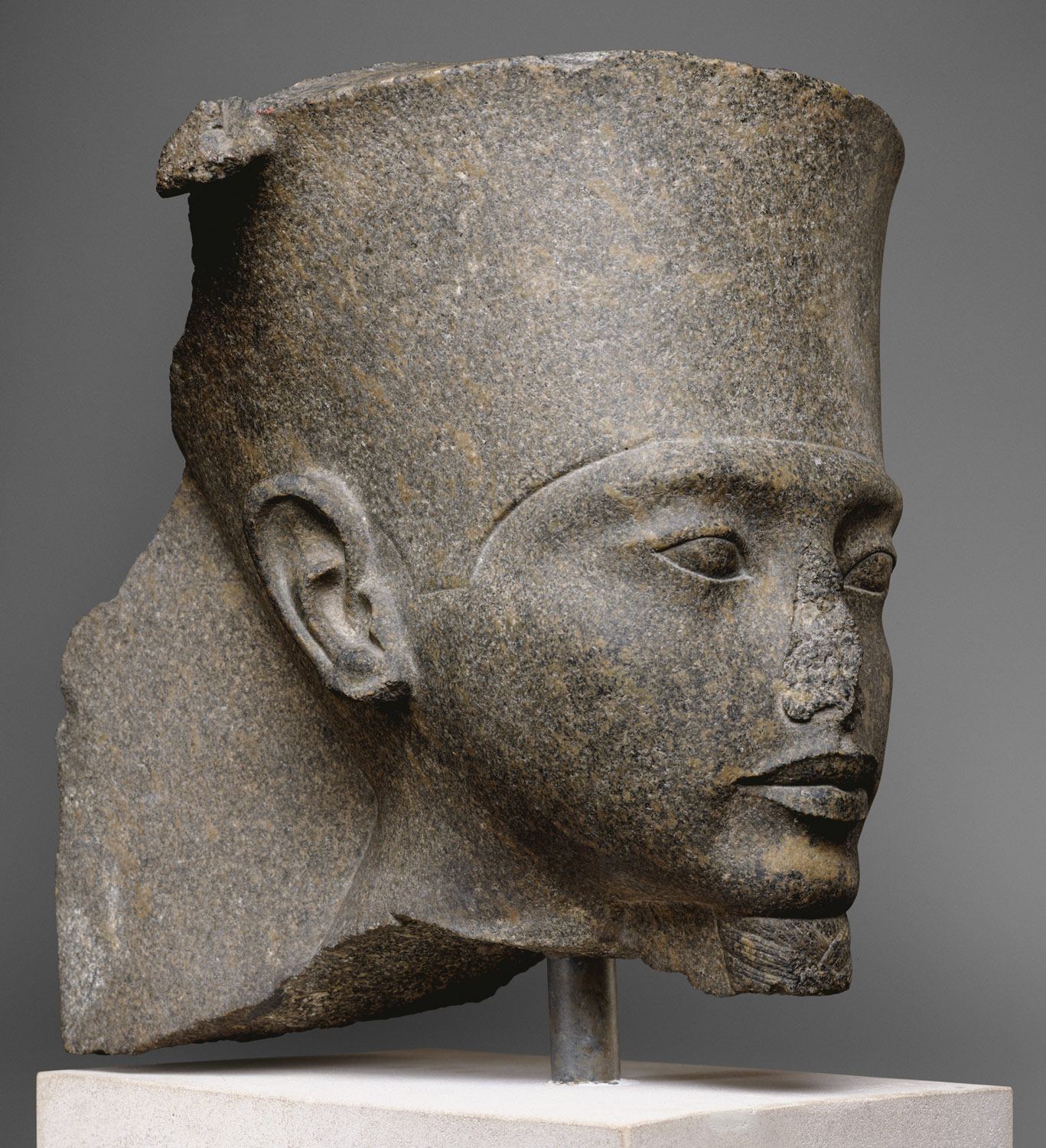
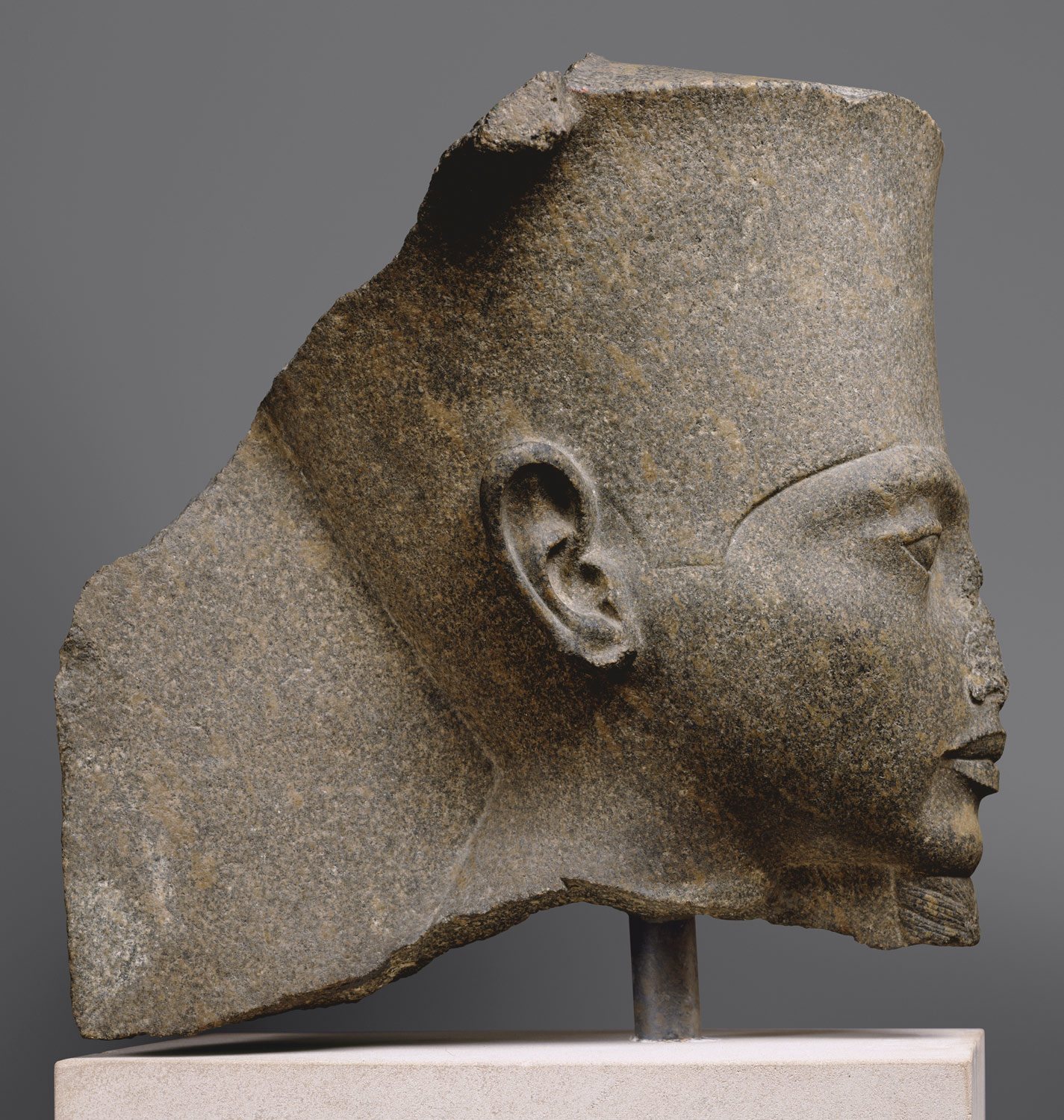
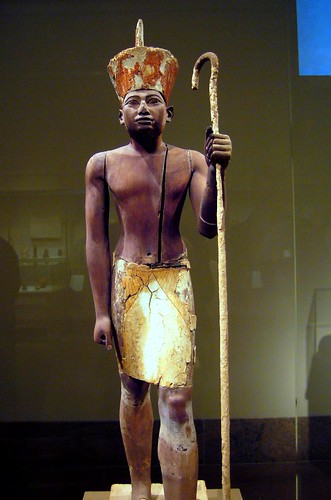


quote:Barry Kemp, "Ancient Egypt Anatomy"
Northern Egypt near the Mediterranean shows the same pattern- limb length data puts its peoples closer to tropically adapted Africans that cold climate Europeans
"...sample populations available from northern Egypt from before the 1st Dynasty (Merimda, Maadi and Wadi Digla) turn out to be significantly different from sample populations from early Palestine and Byblos, suggesting a lack of common ancestors over a long time. If there was a south-north cline variation along the Nile valley it did not, from this limited evidence, continue smoothly on into southern Palestine.
The limb-length proportions of males from the Egyptian sites group them with Africans rather than with Europeans."
quote:Barry Kemp. (2006) Ancient Egypt: Anatomy of a Civilization. p. 54
"When the Elephantine results were added to a broader pooling of the physical characteristics drawn from a wide geographic region which includes Africa, the Mediterranean and the Near East quite strong affinities emerge between Elephantine and populations from Nubia, supporting a strong south-north cline."
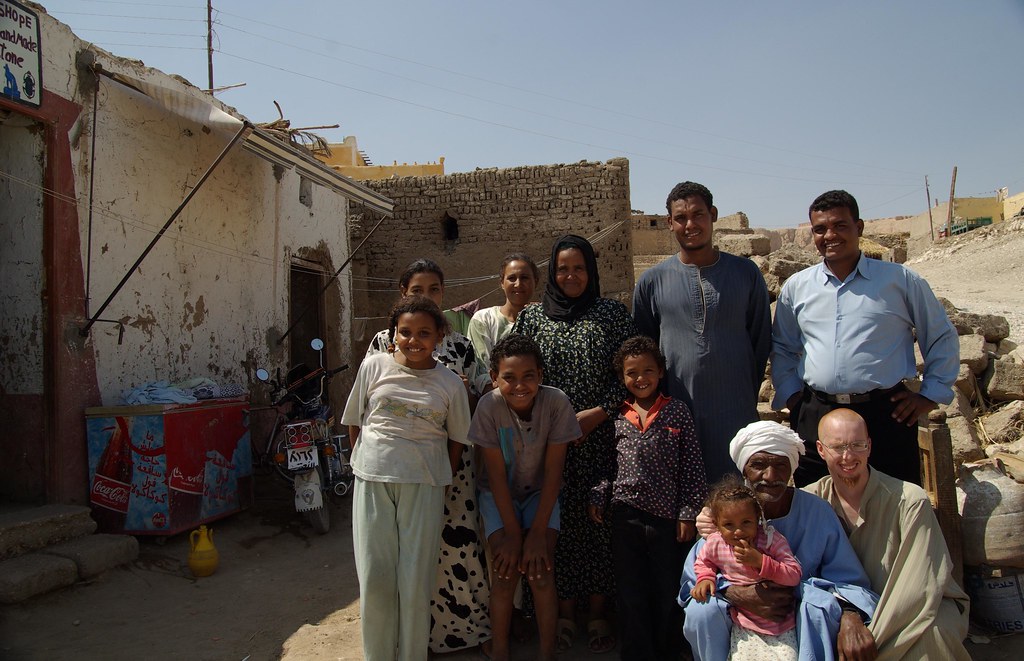
quote:Sad you have to leave, again! Anyway, where is your Saqaliba and Mamluk objectiveness!
Originally posted by melchior7:
I have to say I disagree with many of your responses. I don't know that arguing with you for any length of time will change your minds as you are fervently committed to your beliefs for various reasons. I will say this however, the earliest Africans were Khoisans and Pygmy types carrying haplogroup A and B. We know that they were the earliest inhabitant in East Africa especially Ethiopia. I am pretty sure the current phenotypical "diversity" in Ethiopia and certain other parts of East Africa..you know with regard to "Caucasian features" which y'all claim resulted from the natural adaptation to their environment.. is really due to Eurasian admixture from back migrations going back many of thousands of years. Most Berbers prior to the Moorish invasion were also greatly mixed with Eurasians. You can either be objective and acccept this or continue with your make-believin'...
I'm outta here. Peace.![[Cool]](cool.gif)
quote:
Originally posted by Omo Baba:
^So Duncie, tell us when did this "eurasian admixture" came to east Africa?
Omo I Homo sapiens remain from Ethiopia 190,000 years ago


![[Wink]](wink.gif)
quote:lol, are you serious?
Originally posted by melchior7:
quote:There were early neolithic populations in the Delta area early on.
Originally posted by Brada-Anansi:
Melchior
quote:Who said there was any geographic limits for Blacks, Blacks live all way out in the pacific the ancients certainly did not believe that,nor do genetics and again Kemet for most of it's history was oriented towards inner Africa,only with the arrival of powerful states did they even bothered taking the Med and beyond seriously,namely the Hyksos and the Hittites at first.
But let me ask you, if Blacks lived all the way up to the Delta region then what was the geographic limit for Blacks, and where did Middle Eatern types begin? Also why as it a limit?
Also Blacks in the Pacific have nothing to do with Blacks in Africa.
quote:Implications on Greeks and Ptolemy. Being that the Ptolemy probebly geneticly were E-V13. Which is scarce in Northeast Africa. Attesting that indeed they were minor, especially in the South and Middle of Egypt. At max the frequency is at 2.6% in the South. Middle 5.6% and just a bit higher in the North. I think the autosomal of E-V13 came from admixed Northern Egyptians into the South anyway. Why, because the region was hard to excess for foreigners.
Originally posted by melchior7:
quote:I can't believe you would even question pre islamic back migrations. Is it the New Afrocentric theory now that no back migrations into North Africa ever took place? I guess I've been away too long. I guess genetics is bogus too.
Originally posted by Djehuti:
^ You keep repeating that there were back-migrations. The only significant back-migrations we know of only occurred during Islamic times unless you have proof--valid and uncontested proof-- of back-migrations before this.
As Brada has told you there was NO "limit" for blacks as per evidence of the multiple waves of emmigrations outside of Africa both into Southwest Asia as well as into Europe!! As for 'Middle Eastern' types, the 'Middle East' is a geo-political term of Europeans. If by Middle East you mean Southwest Asia, then there were multiple and diverse types due to its location as a crossroads with some types resembling Africans right next door while other types resembling colder-adapted Eurasian types. The latter which you are no doubt referring to when it comes to the stereotypical light-skinned Middle Easterners quite naturally first appeared in the northern most areas of the 'Middle East' and likely originated from Central Asia, the Caucasus, etc.
You say Eurasians orginated in the Central Asia. Now that's a good start. Obviously they eventually made their way down into the Arabian peninsula, no? So here is another way to ask the question, how far south did these Eurasian types extend during the early days of the Egyptian kingdom??? As you can probably guess, I firmly believe they extended well into North Africa along the coastal areas, and that the Egyptians were a fusion of tropical Africans and these people. Hell even the Badarians seemed to have been mixed.
"By the individual analysis of nasal measurements and indices of the first Badarian series in comparison with the mixed Europoid-Negroid series from Wadi Qitna in Nubia (fourth-fifth century AD), with the Europoid series from Manfalout in Upper Egypt (Ptolemaic period) and with a series of recent Nilotes, I came to the conclusion that the distribution of the Badarian skulls extends from the Europoid to the Negroid range."
"Of the total 117 skulls, 15 were found to be markedly Europoid, 9 of these were of the gracile Mediterranean type, 6 were of very robust structure reminiscent of the North African Cromagnon type. Eight skulls were clearly Negroid... We may conclude that the share of both components was nearly the same, with some overweight to the Europoid side."
"In some of the Badarian crania hair was preserved, thanks to good conditions in the desert sand. In the first series, according to the descriptions of the excavators, they were curly in 6 cases, wavy in 33 cases and straight in 10 cases. They were black in 16 samples, dark brown in 11, brown in 12, light brown in 1 and grey in 11 cases."
Eugen Strouhal,The Journal of African History, Vol. 12, No. 1. (1971),
Say what you want be these folks showed admixture.
quote:
Pharaoh Ptolemy I
Black basalt bust of Pharaoh Ptolemy I of Egypt, dating from the 4th century BC, which was the period of the 30th Dynasty.
Ptolemy I was also known as Ptolemy Soter, meaning 'saviour', and before becoming Pharaoh of Egypt, was a Macedonian general who served under Alexander the Great. With Alexander, he served in many military campaigns, including those in India, Babylon, Persia, and Afghanistan. After Alexander's death, Ptolemy was appointed Satrap (governor) of Egypt, and later took the title of Pharaoh, founding the Ptolemaic dynasty.
quote:
Series
The Cambridge Ancient History
Volume 3 Part 3
The Expansion of the Greek World, Eighth to Sixth Centuries B.C.
Chapter Title
Chapter 36b: The Greeks in Egypt
Publication Date
1982
Author
T. F. R. G. Braun
Digital Object Identifier (DOI)
10.1017/CHOL9780521234474.003
Overview
Greek-Egyptian relations before Psammetichus I
Greeks arrived to settle in Egypt in the reign of Psammetichus I (664–610 B.C.). For the period that follows, Herodotus found that Egyptian and non-Egyptian information could be combined (II. 147). Thanks to Greek settlers mingling with the Egyptians, knowledge was now accurate (II. 154). Significantly, no Greek pottery datable to the period between Mycenaean times and 664 B.C. has so far been found in Egypt. Egyptian trinkets, on the other hand, were reaching the Greek world in the eighth century, and a bronze Egyptian jug at Lefkandi in Euboea would seem to date back as far as the ninth. These could have arrived by way of Phoenicia or Cyprus.
Some contact then, even if indirect, there must have been in the disturbed century before Psammetichus I. The Greeks retained some recollection of the Egyptian history of this time. We have seen how the king of Ethiopia and Egypt, who must have been Shabako (c. 716–c. 702 B.C.) in 711 surrendered Yamani of Ashdod, possibly a Greek (above, p. 16). This ‘Sabakōs’ is an historical figure for Herodotus (II. 137, 139) who in the fifth century could get a fair amount of information about the 25th (Nubian or Kushite) dynasty. Shabako's enemy was the delta king Bakenrenef son of Tefnakhte (c. 720–715 ?), whom he eventually captured and burnt alive. Bakenrenef, as Bocchoris, was to figure in Greek imagination, though Herodotus does not mention him. He is celebrated as a sagacious lawgiver in the Egyptian account of Diodorus (I. 45, 65, 79, 94) which derives from earlier Greek writing – probably in large measure from Hecataeus of Abdera, c. 300 B.C.

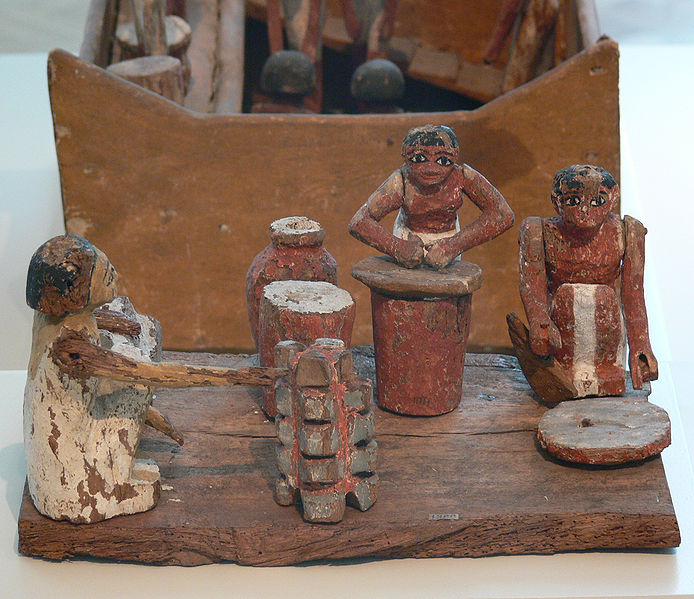

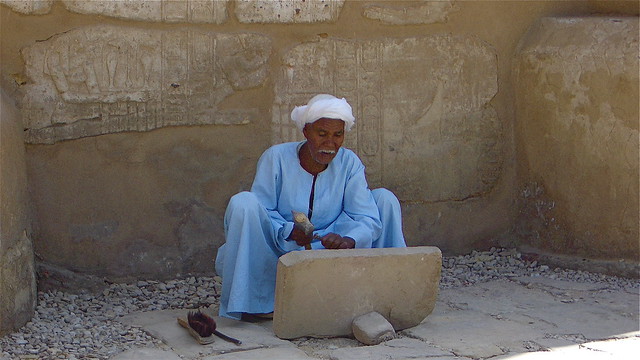
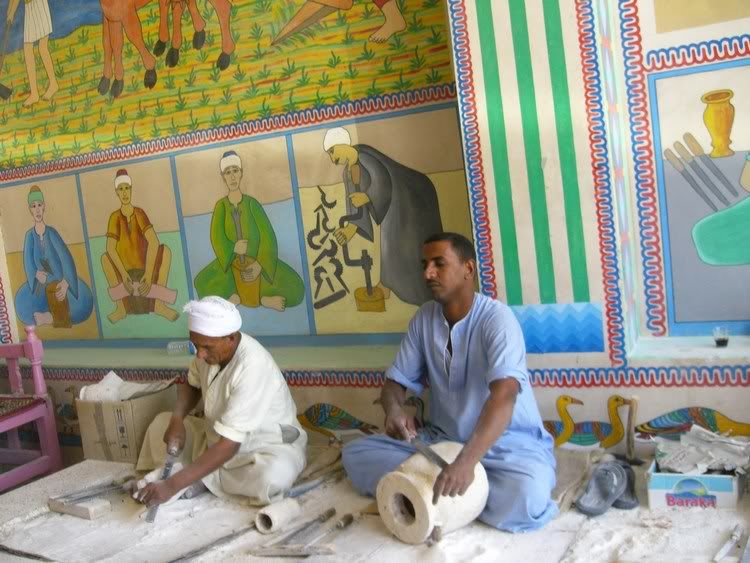
quote:Jesus Christmas! - your darn right it wasn't a barrier which is why the entire corpus of rock art shows mainly black spear chucking Africans LIVING IN MESOLITHIC AND NEOLITHIC IBERIA dimwit.
Originally posted by melchior7:
quote:Let’s not start flinging insults so early in the game.
Originally posted by dana marniche:
You people are really a trip. lol!. What I know is that you are definitely as block headed as your Neanderdull brethren. That's what I know. Are you telling me Berbers did not give anything to Moorish Spain.
Here is one thing of many things for you to learn about the black people called Berbers. The word for horsmanship in Spain "Jinete" is derived from the Zenetes or Zanata Berbers i.e. Zaghawa or Azuwagha horsemen.
"Originally, it meant a type of light cavalryman, proficient at skirmishing and rapid maneuver."
They also brought the jousting and javelins into Iberia, probably much like what was happening in the region of Bornu among Zaghawa related peoples there.![[Smile]](smile.gif)
BTW - The sholarly i.e. non-Euronut sources on the Cantigas say they depict Muslims not necessarily Berbers and Arabs. in fact it is recognized they could be depicting people from anywhere in the Middle East.
So your Euronut site explanation is not going to work here.
The word Moor was a synonym for Negro among Mozarabs and I am just explaining why.![[Smile]](smile.gif)
Hydraulics of course is another wonderful introduction of the Africans whose ancestors were the "pitch black" Garamantes, Gamphasantes Ghadmusii, Tidamensii and other peoples who possessed complex systems of irrigation and hydraulics as early as 4000 years ago.
A foggara of Gourara a town of Central Algeria, where live Zanata berbers. The technology for Afro Berber irrigation practices dates back thousands of years.
You are pitiful. Why are you so jealous of these Africans.
They are descendants of the Ibadites and Kharijites pushed southwards by later Arab invaders from northern parts of eastern Maghreb.And you don’t know what race I am but if it means anything to you, I am not white. Let me start by saying that I find it interesting that you would think that a stretch of water eight miles wide between Spain and North Africa would act as such an effective racial barrier where you would have Whites and one side and Blacks on the other despite the archaeological and historical evidence which shows migrations gong back and forth from continent to continent over many millennia.
quote:LOL! That figures.
Originally posted by Djehuti:
quote:Didn't you post this picture before last year or so only to have it refuted as NOT a Medieval portrait but a picture made in MODERN times by someone out of pure imagination??
Originally posted by malcontent7:
Again they were initially called Moros in Spain because of where they came from ( Mauretania) not because of what they looked like. Most the Berbers who crossed over into Spain were light skinned. Tarik himself was described as having red hair and an early depiction shows him to be simply a tawny Berber.
quote:You are basically too much of a bald- faced liar to even respond to. You suggest here that they have Garamantian dna . lol! Why didn't you post it!
Originally posted by melchior7:
quote:...
Originally posted by dana marniche:
You people are really a trip. lol!. What I know is that you are definitely as block headed as your Neanderdull brethren. That's what I know. Are you telling me Berbers did not give anything to Moorish Spain.
Here is one thing of many things for you to learn about the black people called Berbers. The word for horsmanship in Spain "Jinete" is derived from the Zenetes or Zanata Berbers i.e. Zaghawa or Azuwagha horsemen.
"Originally, it meant a type of light cavalryman, proficient at skirmishing and rapid maneuver."
They also brought the jousting and javelins into Iberia, probably much like what was happening in the region of Bornu among Zaghawa related peoples there.![[Smile]](smile.gif)
BTW - The sholarly i.e. non-Euronut sources on the Cantigas say they depict Muslims not necessarily Berbers and Arabs. in fact it is recognized they could be depicting people from anywhere in the Middle East.
So your Euronut site explanation is not going to work here.
The word Moor was a synonym for Negro among Mozarabs and I am just explaining why.![[Smile]](smile.gif)
Hydraulics of course is another wonderful introduction of the Africans whose ancestors were the "pitch black" Garamantes, Gamphasantes Ghadmusii, Tidamensii and other peoples who possessed complex systems of irrigation and hydraulics as early as 4000 years ago.
A foggara of Gourara a town of Central Algeria, where live Zanata berbers. The technology for Afro Berber irrigation practices dates back thousands of years.
You are pitiful. Why are you so jealous of these Africans.
They are descendants of the Ibadites and Kharijites pushed southwards by later Arab invaders from northern parts of eastern Maghreb.
As far as the Garamantes, I take nothing from them. I don’t know what their race was as there are varying reports. For example Herodotus claims they chased after Black trogolodytes. Others claim they were Blacks. But yet they have had the highest frequencies of Mtdna H1 a European marker than anywhere else in the world.
quote:Hammer the second. You will never no peace. I guarantee it.
Originally posted by melchior7:
I have to say I disagree with many of your responses. I don't know that arguing with you for any length of time will change your minds as you are fervently committed to your beliefs for various reasons. I will say this however, the earliest Africans were Khoisans and Pygmy types carrying haplogroup A and B. We know that they were the earliest inhabitant in East Africa especially Ethiopia. I am pretty sure the current phenotypical "diversity" in Ethiopia and certain other parts of East Africa..you know with regard to "Caucasian features" which y'all claim resulted from the natural adaptation to their environment..is really due to Eurasian admixture from back migrations going back many of thousands of years. Most Berbers prior to the Moorish invasion were also greatly mixed with Eurasians. You can either be objective and acccept this or continue with your make-believin'...
I'm outta here. Peace.![[Cool]](cool.gif)
![[Wink]](wink.gif)
quote:Kurds?! You will forever be a wacko like your brethren incapable of separating the current north Levant descended Egyptians from ancient Great lakes African pharaohs!
Originally posted by melchior7:
quote:I really don't want to get into this sh!t again. But let me ask you, if Blacks lived all the way up to the Delta region then what was the geographic limit for Blacks, and where did Middle Eatern types begin? Also why was it a limit?
Originally posted by -Just Call Me Jari-:
Other than pockets of Foreign migrants in later Times, you have proof to back up your claim that "Lower Egyptians were not Black" as opposed that Upper Egyptians were "Mostly" blacks
quote:
"There is now a sufficient body of evidence from modern studies of skeletal remains to indicate that the ancient Egyptians, especially southern Egyptians, exhibited physical characteristics that are within the range of variation for ancient and modern indigenous peoples of the Sahara and tropical Africa.. In general, the inhabitants of Upper Egypt and Nubia had the greatest biological affinity to people of the Sahara and more southerly areas." (Nancy C. Lovell, " Egyptians, physical anthropology of," in Encyclopedia of the Archaeology of Ancient Egypt, ed. Kathryn A. Bard and Steven Blake Shubert, ( London and New York: Routledge, 1999) pp 328-332)quote:
Originally posted by melchior7:
The ones in upper Egypt were mostly Balck. But not those in lower Egypt.
![[Smile]](smile.gif)
Likely if Blacks reached up to the Mediterranean coast then they would have spilled over into Europe and the Middle East, or else it was Eurasians who spilled over into North Africa. I think the evidence supports the later scenario.
Why did the Egyptians portray themselves as lighter than the Nubians to the south? Why would they be lighter if Egypt is hot as hell? Why do so many Egyptians mummies have fine features and striaght or wavy hair?
With Haplogroups R and T found in Egytians, how can anyone deny that a good part of their genetic make up reflects a back to Africa migration from West Asia?
Something I just found:
"There is an Egyptian-specific component, of West Eurasian affinity (look at the Fst table), what implies that it's surely descendant of the pre-Neolithic Egyptians of Asian origin. Paleolithic Egyptians that I presume existed based on other genetics (mtDNA X1, M1 and such), as well as Eurasian-like iconography like the Qurta rock art, similar to materials from SW Europe and Anatolia (but admittedly the Egyptian Paleolithic, with a few exceptions, is not well known on archaeological grounds being such a sedimentary and then desertic area overall, and also because archaeology in Egypt has been largely focused on the quite impressive pharaonic period).
This Egyptian-specific component represents 29% of one sample but only 19% of the other one, being also of some relevance in Ethiopia (9%). This and other differences between the two samples suggest some structure to be unveiled within Egypt but I lack the means (diverse enough samples) to do it. Anyhow the two samples are only somewhat different.
Besides this component, Egyptians show a diverse array of external influences, possibly Neolithic immigrants (?). The most important ones are the Kurdish or Highland West Asian component (17-20%) and the two Arab components together (14-25%) but others (Berber, Palestinian, East African) are also quite influential. The Iberian influence was largely a mirage (although still weights 4-8%)".
http://forwhattheywereweare.wordpress.com/2012/01/30/egyptian-autosomal-genetics-in-the-regional-context-quick-admixture-run/
NEVER FORGET that Egypt is not deep into Africa but at the crossroads bordering the Mediterrean and the Middle East!
![[Roll Eyes]](rolleyes.gif)

quote:
Originally posted by malcontent7:
Again they were initially called Moros in Spain because of where they came from ( Mauretania) not because of what they looked like. Most the Berbers who crossed over into Spain were light skinned. Tarik himself was described as having red hair and an early depiction shows him to be simply a tawny Berber.
quote:no such refutation was made
Originally posted by Djehuti:
Didn't you post this picture before last year or so only to have it refuted as NOT a Medieval portrait but a picture made in MODERN times by someone out of pure imagination??
quote:If he was a Hasa of the Nafzawa that would make it even less likely that he was "red haired" unless he was of course using henna.
Originally posted by the lioness:
quote:
Originally posted by malcontent7:
Again they were initially called Moros in Spain because of where they came from ( Mauretania) not because of what they looked like. Most the Berbers who crossed over into Spain were light skinned. Tarik himself was described as having red hair and an early depiction shows him to be simply a tawny Berber.
quote:no such refutation was made
Originally posted by Djehuti:
Didn't you post this picture before last year or so only to have it refuted as NOT a Medieval portrait but a picture made in MODERN times by someone out of pure imagination??
There are three different accounts of Tariq ibn Ziyad origins given by Arabic histories.
1) He was a Persian from Hamadan.
2) He was an Arab of the Sadf tribe.
3) He was a Berber from North Africa.
The 13th-century historian Ibn Idhari states he was from the Ulhasa (French: Oulhaça) tribe.
the Ulhasa originate from a branch of the Nefzaouas people and part of the Zeneta .
According to Ibn Khaldun, the Ulhasa could be found at that time on both sides of the Tafna river in Tlemcen, Algeria.
Most historians, Arab and Spanish, seem to agree that he was a slave of the emir of Ifriqiya (North Africa), Musa bin Nusayr, who gave him his freedom and appointed him a general in his army. But his descendants centuries later denied he had ever been Musa's slave.
![[Wink]](wink.gif)
quote:What's more, Ibn Khaldun called himself correcting other historians but he relied, like them, on biblical mythology.
Originally posted by dana marniche:
If he was a Hasa of the Nafzawa that would make it even less likely that he was "red haired" unless he was of course using henna.
Modern Jebel Nafusa Berbers certainly don't look much like that painting. Neither did the Zanata of Ibn Khaldun's time evidently since he writes of people saying Berbers were black because they were cursed descendants of Canaan and claimed the Zanata were the largest of the Berber tribes of his day.![[Wink]](wink.gif)
Sergi describes the peoples of the oases of Nafzawa and Wed Suef and Wed Regh and other Berbers of the Sus as “of very dark complexion” in Guiseppi Sergi The Mediterranean Race. [/QB]
quote:But at least the Andalusian Khaldun said that most people believed this is why the Berbers of his time (14th century) were black, and incidentally that Central Arabia, Hijaz and Yemen etc were a "zone of Sudan".
Originally posted by HERU:
quote:What's more, Ibn Khaldun called himself correcting other historians but he relied, like them, on biblical mythology.
Originally posted by dana marniche:
If he was a Hasa of the Nafzawa that would make it even less likely that he was "red haired" unless he was of course using henna.
Modern Jebel Nafusa Berbers certainly don't look much like that painting. Neither did the Zanata of Ibn Khaldun's time evidently since he writes of people saying Berbers were black because they were cursed descendants of Canaan and claimed the Zanata were the largest of the Berber tribes of his day.![[Wink]](wink.gif)
Sergi describes the peoples of the oases of Nafzawa and Wed Suef and Wed Regh and other Berbers of the Sus as “of very dark complexion” in Guiseppi Sergi The Mediterranean Race.
“Ham, having become black because of a curse pronounced against him by his father, fled to the Maghrib to hide in shame...Berber, son of Kesloudjim [Casluhim], one of his descendants, left numerous posterity in the Maghrib." - Ibn Khaldun, Histoire I, 177–178 [/QB]
![[Smile]](smile.gif)
quote:The Christians of Iberia used the term Moor to describe all the Muslims black and not black at that time.
Originally posted by dana marniche:
quote:But at least the Andalusian Khaldun said that most people believed this is why the Berbers of his time (14th century) were black, and incidentally that Central Arabia, Hijaz and Yemen etc were a "zone of Sudan".
Originally posted by HERU:
quote:What's more, Ibn Khaldun called himself correcting other historians but he relied, like them, on biblical mythology.
Originally posted by dana marniche:
If he was a Hasa of the Nafzawa that would make it even less likely that he was "red haired" unless he was of course using henna.
Modern Jebel Nafusa Berbers certainly don't look much like that painting. Neither did the Zanata of Ibn Khaldun's time evidently since he writes of people saying Berbers were black because they were cursed descendants of Canaan and claimed the Zanata were the largest of the Berber tribes of his day.![[Wink]](wink.gif)
Sergi describes the peoples of the oases of Nafzawa and Wed Suef and Wed Regh and other Berbers of the Sus as “of very dark complexion” in Guiseppi Sergi The Mediterranean Race.
“Ham, having become black because of a curse pronounced against him by his father, fled to the Maghrib to hide in shame...Berber, son of Kesloudjim [Casluhim], one of his descendants, left numerous posterity in the Maghrib." - Ibn Khaldun, Histoire I, 177–178[/QB]
quote:At what time only at a very late period of time. lol! Before that as Simonet said early on the Christian Mozarabs used it as a synonym for "Negro" black.
Originally posted by the lioness:
quote:"The Christians of Iberia used the term Moor to describe all the Muslims black and not black at that time."[/QB]
Originally posted by dana marniche:
quote:But at least the Andalusian Khaldun said that most people believed this is why the Berbers of his time (14th century) were black, and incidentally that Central Arabia, Hijaz and Yemen etc were a "zone of Sudan".
Originally posted by HERU:
quote:What's more, Ibn Khaldun called himself correcting other historians but he relied, like them, on biblical mythology.
Originally posted by dana marniche:
If he was a Hasa of the Nafzawa that would make it even less likely that he was "red haired" unless he was of course using henna.
Modern Jebel Nafusa Berbers certainly don't look much like that painting. Neither did the Zanata of Ibn Khaldun's time evidently since he writes of people saying Berbers were black because they were cursed descendants of Canaan and claimed the Zanata were the largest of the Berber tribes of his day.![[Wink]](wink.gif)
Sergi describes the peoples of the oases of Nafzawa and Wed Suef and Wed Regh and other Berbers of the Sus as “of very dark complexion” in Guiseppi Sergi The Mediterranean Race.
“Ham, having become black because of a curse pronounced against him by his father, fled to the Maghrib to hide in shame...Berber, son of Kesloudjim [Casluhim], one of his descendants, left numerous posterity in the Maghrib." - Ibn Khaldun, Histoire I, 177–178![[Smile]](smile.gif)
quote:Exactly and the Syrians, Iranians, Andalusians call all of them "black-skinned". That is only your hope and dream that they were all very much mixed. But as Ibn Butlan tells us there were only "a few pale women among them" and nobody ever mentions a single tribe as being fair in color before the 16th century.
"The Moors who invaded Iberia were largely Berber who came from the ancient Roman provinces in costal North Africa, Numidia and Mauretania."
quote:The word Berber has already been redefined by north african nationalists, Neandernutcase.
"You could redefine what the world calls "Berber" and say Berbers are only 100% indigenous Africans. "
![[Big Grin]](biggrin.gif)

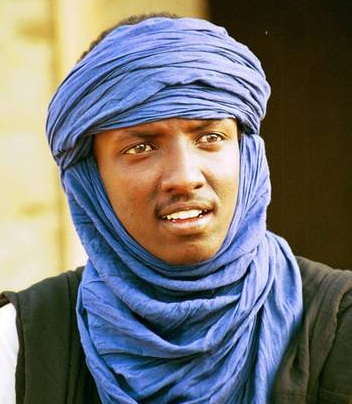


quote:correct all the above people would be regarded as black by the ancient writers
Originally posted by dana marniche:
Exactly and the Syrians, Iranians, Andalusians call all of them "black-skinned".
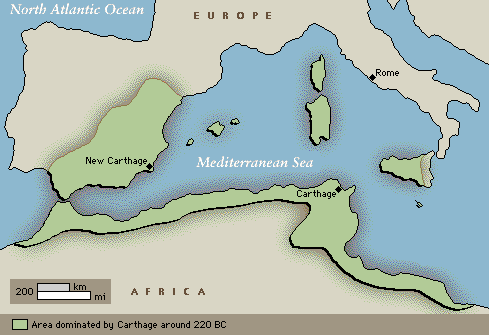

quote:It's funny how you wholeheartedly fight with tooth and nail every contribution of the African. Trying to reduce it at every cost. Now it has even come to the point, where you now are making up sh*t again. It's "science fiction" in the true sense of the word.
Originally posted by the lioness:


quote:correct all the above people would be regarded as black by the ancient writers
Originally posted by dana marniche:
Exactly and the Syrians, Iranians, Andalusians call all of them "black-skinned".
Before the Moors invaded Iberia there was Carthage, founded by Phoenicians, populated by half a million people in the same region that was to become the Roman Provinces of Numidia and Mauritania
Carthage

Numidia [11] and Mauritania [25]

the picture is obvious,most of these regions overlap, the foreignes who came into the area did not disappear. They became Muslims and joined the invasion
.


quote:Sorry Patrol - you misunderstood me. I said Syrian, Roman and Iranian looking people like these referred to ALL Berbers as blacks. So Syrians and Romans didn't consider themselves black. And neither do I.
Originally posted by the lioness:
quote:correct all the above people would be regarded as black by the ancient writers
Originally posted by dana marniche:
Exactly and the Syrians, Iranians, Andalusians call all of them "black-skinned".
Before the Moors invaded Iberia there was Carthage, founded by Phoenicians, populated by half a million people in the same region that was to become the Roman Provinces of Numidia and Mauritania
Carthage

Numidia [11] and Mauritania [25]

the picture is obvious,most of these regions overlap, the foreignes who came into the area did not disappear. They became Muslims and joined the invasion
.
![[Big Grin]](biggrin.gif)


quote:Yes it is probably a Neanderthick skull that a baseball wouldn't make a dent in. However, I am certain the Neandernut blockheadedness this wacko exhibits like other wackos persistently is based on jealousy of blacks. Only some kind of animal half-crazed with jealousy could be that persistent in its irrationality and attempt to sabotage like a Ku Klux Klansmen or an perhaps autistic person of some sort.
Originally posted by Troll Patrol:
quote:It's funny how you wholeheartedly fight with tooth and nail every contribution of the African. Trying to reduce it at every cost. Now it has even come to the point, where you now are making up sh*t again. It's "science fiction" in the true sense of the word.
Originally posted by the lioness:

quote:correct all the above people would be regarded as black by the ancient writers
Originally posted by dana marniche:
Exactly and the Syrians, Iranians, Andalusians call all of them "black-skinned".
Before the Moors invaded Iberia there was Carthage, founded by Phoenicians, populated by half a million people in the same region that was to become the Roman Provinces of Numidia and Mauritania
Carthage

Numidia [11] and Mauritania [25]

the picture is obvious,most of these regions overlap, the foreignes who came into the area did not disappear. They became Muslims and joined the invasion
.
Why don't you go into details like Dana does? Is it because you lack the actual knowledge? Instead of generalizing with baseless random picture spamming.
So many times it has been explained the coastal North Africans have mostly admixture or are at times completely foreign to the continent. I wonder, when will it sink into your thick skull?

![[Eek!]](eek.gif)

quote:You are saying the same thing I am saying.
Originally posted by Troll Patrol:
So many times it has been explained the coastal North Africans have mostly admixture or are at times completely foreign to the continent. I wonder, when will it sink into your thick skull?
quote:You said this in the Kabyle thread. It's wrong Tuareg are Berbers also but most of them live South of other Berbers. They live mainly in Mali and Niger but also some other places.
Originally posted by Troll Patrol:
Some of the people in your post aren't Berber, but Tuareg.
quote:What I wrote in my previous post was. You can't go in to detailed arguments like Dana. So all you have as a response is a picture spam. And you still have no argument to the original inhabitants of North Africa. So much for your sarcasm, I don't see, what this has to do what a billion threads you have started. As if I have time to sit here all day...reading and responding to all your "race argument" threads. Day-in-day-out.lol
Originally posted by the lioness:
Numidia [11] and Mauritania [25]
quote:You are saying the same thing I am saying.
Originally posted by Troll Patrol:
So many times it has been explained the coastal North Africans have mostly admixture or are at times completely foreign to the continent. I wonder, when will it sink into your thick skull?
I'm saying is that most of the people in Africa who invaded the Iberian peninsula came from these coastal North African regions, Numidia and Maurentania.
Those are mixed regions that include many foreigners and have been mixed since before the birth of Christ.
They are part of the Berbers and Berbers also include indigenous Africans.
quote:You said this in the Kabyle thread. It's wrong Tuareg are Berbers also but most of them live South of other Berbers. They live mainly in Mali and Niger but also some other places.
Originally posted by Troll Patrol:
Some of the people in your post aren't Berber, but Tuareg.
Let me inform you of some recent threads I made:
1)
Senegambian stone circles/Serer Religion
http://www.egyptsearch.com/forums/ultimatebb.cgi?ubb=get_topic;f=8;t=008161;p=1#000000
ONE REPLY
_______________________________________________
2)
DNATribes: Atlantic Megalith Builders: Basque and North African
http://www.egyptsearch.com/forums/ultimatebb.cgi?ubb=get_topic;f=8;t=008157;p=1#000000
a few replies
_______________________________________________
3)
Sign Petition: keep subsidy for N.I.N.S.E study of Dutch Slavery
http://www.egyptsearch.com/forums/ultimatebb.cgi?ubb=get_topic;f=15;t=006989;p=1#000000
NO REPLIES, PATHETIC people would rather worship European aristocrats rather than see their relation to the slave trade
___________________________________________________
4)
Africapitalism-Tony Elumelu
http://www.egyptsearch.com/forums/ultimatebb.cgi?ubb=get_topic;f=15;t=006885;p=1#000000
TWO REPLIES FROM ONE PERSON ONLY
___________________________________________________
5)
real Moorish literature
http://www.egyptsearch.com/forums/ultimatebb.cgi?ubb=get_topic;f=15;t=006887;p=1#000000
people would rather have wet dreams about the Hapsburgs being Moors than read actual Moorish literature
______________________________________________
6)
New York police frisk more people despite criticism
http://www.egyptsearch.com/forums/ultimatebb.cgi?ubb=get_topic;f=15;t=006868;p=1#000000
ZERO REPLIES
______________________________________________________
7)
In Egypt Turmoil, Thieves Hunt Pharaonic Treasures
http://www.egyptsearch.com/forums/ultimatebb.cgi?ubb=get_topic;f=8;t=008143;p=1#000000
ZERO REPLIES
_________________________________________________________
so I blame all of you for preferring "RACE WAR" topics
.

quote:Yet what you said has nothing to do with the issue of that picture Malcontent keeps posting which was found to be made in recent modern times.
Originally posted by the lyinass:
quote:
Originally posted by malcontent7:
Again they were initially called Moros in Spain because of where they came from ( Mauretania) not because of what they looked like. Most the Berbers who crossed over into Spain were light skinned. Tarik himself was described as having red hair and an early depiction shows him to be simply a tawny Berber.
quote:no such refutation was made
Originally posted by Djehuti:
Didn't you post this picture before last year or so only to have it refuted as NOT a Medieval portrait but a picture made in MODERN times by someone out of pure imagination??
There are three different accounts of Tariq ibn Ziyad origins given by Arabic histories.
1) He was a Persian from Hamadan.
2) He was an Arab of the Sadf tribe.
3) He was a Berber from North Africa.
The 13th-century historian Ibn Idhari states he was from the Ulhasa (French: Oulhaça) tribe.
the Ulhasa originate from a branch of the Nefzaouas people and part of the Zeneta .
According to Ibn Khaldun, the Ulhasa could be found at that time on both sides of the Tafna river in Tlemcen, Algeria.
Most historians, Arab and Spanish, seem to agree that he was a slave of the emir of Ifriqiya (North Africa), Musa bin Nusayr, who gave him his freedom and appointed him a general in his army. But his descendants centuries later denied he had ever been Musa's slave.
quote:lol the lengths they will go to deceive.lol
Originally posted by Djehuti:
quote:Yet what you said has nothing to do with the issue of that picture Malcontent keeps posting which was found to be made in recent modern times.
Originally posted by the lyinass:
quote:
Originally posted by malcontent7:
Again they were initially called Moros in Spain because of where they came from ( Mauretania) not because of what they looked like. Most the Berbers who crossed over into Spain were light skinned. Tarik himself was described as having red hair and an early depiction shows him to be simply a tawny Berber.
quote:no such refutation was made
Originally posted by Djehuti:
Didn't you post this picture before last year or so only to have it refuted as NOT a Medieval portrait but a picture made in MODERN times by someone out of pure imagination??
There are three different accounts of Tariq ibn Ziyad origins given by Arabic histories.
1) He was a Persian from Hamadan.
2) He was an Arab of the Sadf tribe.
3) He was a Berber from North Africa.
The 13th-century historian Ibn Idhari states he was from the Ulhasa (French: Oulhaça) tribe.
the Ulhasa originate from a branch of the Nefzaouas people and part of the Zeneta .
According to Ibn Khaldun, the Ulhasa could be found at that time on both sides of the Tafna river in Tlemcen, Algeria.
Most historians, Arab and Spanish, seem to agree that he was a slave of the emir of Ifriqiya (North Africa), Musa bin Nusayr, who gave him his freedom and appointed him a general in his army. But his descendants centuries later denied he had ever been Musa's slave.
quote:yet you keep claiming the picture was made in recent times but have zero proof.
Originally posted by Djehuti:
Yet what you said has nothing to do with the issue of that picture Malcontent keeps posting which was found to be made in recent modern times.
![[Roll Eyes]](rolleyes.gif)

![[Wink]](wink.gif)

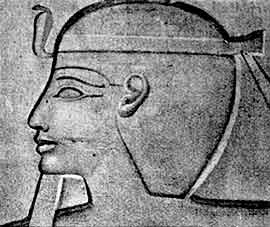





quote:http://www.oocities.org/ihusselbee/crusader/moors2.htm [/QB
Originally posted by melchior7:
quote:Your depiction of Blacks in hooded garments looks very interesting. But is propaganda and likely racist showing that “Blacks” are supporters of the antichrist. This does not tell what most of the Moors in Spain looked like. The Cantigas portrayed scenes from everyday life.
Originally posted by Brada-Anansi:

Dates from the 1400's
The term Moor predates Muslims, and it has always meant black we covered this time and again but Lioness like to keep rehashing old arguments and yes ,Djehuti every Black was a Moor but all Moors weren't Blacks especially by late medieval times, St Maurice for instance was a Moor but he was non Muslim and did not hail from North West Africa and below the Roman writer Martial inter change Moor with Ethiopians,so too did Juvenal
“Grieve not at this, poor wretch, and with thine own hand give thy wife the potion whatever is be for did she choose to bear her leaping children in her womb thou wouldst, perchance, become the sire of an Ethiop, a blackamoor would soon be your sole heir.”
- Juvenal, Satire VI, lines 596 – 600
“One of them, with wooly hair, like a Moor, seems to be the son of Santra, the cook. The second, with a flat nose and thick lips, is the image of Pannicus, the wrestler . . . of the two daughters, one is black . . . and belongs to Crotus, the flute player.”
Martial, VI, 39.
“When tired of each noblest matron, (Gildo) hands her over to the Moors. These Sidonian mothers, married in Carthage City, must needs be mate with barbarians. He thrusts upon me an Ethiopian son-in-law. This hideous hybrid affects the cradle.”
Claudian.
Read more: http://egyptsearchreloaded.proboards.com/index.cgi?board=bag&action=display&thread=25&page=3#ixzz1wqeojFyn
Again they were initially called Moros in Spain because of where they came from ( Mauretania) not because of what they looked like. Most the Berbers who crossed over into Spain were light skinned. Tarik himself was described as having red hair and an early depiction shows him to be simply a tawny Berber.
Other Europeans may have associated the word Moor for Black but they really didn’t have the concept of race as we do today. Moor just referred to swarthy people coming from the other side of the Mediterranean. When the Spanish invented the term Negro, the English and others followed suit and a clear racial distinction was made..
You may be familiar with the color ranking of the Roman Manilius. It shows that among dark peoples the mauritanians were the lighest.
In Manilius' order swarthy complexions from the most
dark to the least dark are
- Aethiopes
- India
- Aegyptia
- Afrorum
- Mauretania
This would seem to be in accordance with the majority of light brown folk we see in North Africa today.
Most Blacks brought to Spain came with the Almoravids. They were not North Africans but recruited form Senegal and Mali. It’s documented.
“Yusuf ibn Tashfin , second Almoravid leader and man destined to conquer Andalus, reorganised these armies. Original Almoravid forces had been a tribal confederation, but yusuf changed the command structure and created a personal force of black slaves and foreigners. His bodyguard consisted of 500 non-Berber horsemen, including Arabs, Turks and Europeans, supported by a further 2,000 black African cavalry. Christian mercenaries as well as converted Spanish prisoners continued to fight for the Almoravids and their successors both in Andalus and North Africa throughout the late 11th and 12th centuries.
Cavalry also became more important than camel-mounted troops, particularly when operating in Andalus. There the high number of black Africans in Almoravid armies, many recruited from Senegal on the southern frontier of the empire, had a terrifying effect on Christian morale- as did the use of massed drums, unusual forms of bow, enormously long leather shields, bamboo spears and other unfamiliar weapons. A continuing use of large number camels also unsettled the Spaniards’ horses, in fact, such animals had been known in southern Andalus since at least the 10th century.”
http://www.oocities.org/ihusselbee/crusader/moors2.htm
![[Big Grin]](biggrin.gif)
 Pure Tuareg = East African = woolly- haired black African
Pure Tuareg = East African = woolly- haired black African![[Wink]](wink.gif)

![[Wink]](wink.gif)
 MG]
MG] ![[Big Grin]](biggrin.gif)
![[Big Grin]](biggrin.gif)
quote:Don't put words in my mouth Neanderwoman. I said people can be whatever they want.
Originally posted by the lioness:
Djehuti, don't get brainwashed by dana
she says this never happened:
Greeks from Europe and the Phoenicians from Asia also settled along the coast of Northern Africa. Both societies drew their prosperity from the sea and from ocean-born trade. They found only limited trading opportunities with the native inhabitants, and instead turned to colonization. The Greek trade was based mainly in the Aegean, Adriatic, Black, and Red Seas and they only established major cities in Cyrenaica, directly to the south of Greece. In 332 BC, Alexander the Great conquered Egypt and for the next three centuries it was ruled by the Greek Ptolemaic dynasty.
The Phoenicians developed an even larger presence in North Africa with colonies from Tripoli to the Atlantic. One of the most important Phoenician cities was Carthage, which grew into one of the greatest powers in the region. At the height of its power, Carthage controlled the Western Mediterranean and most of North Africa outside of Egypt. However, Rome, Carthage's major rival to the north, defeated it in a series of wars known as the Punic Wars, resulting in Carthage's destruction in 146 BC and the annexation of its empire by the Romans. In 30 BC, Roman Emperor Octavian conquered Egypt, officially annexing it to the Empire and, for the first time, unifying the North African coast under a single ruler.
The Carthaginian power had penetrated deep into the Sahara ensuring the quiescence of the nomadic tribes in the region. The Roman Empire was more confined to the coast, yet routinely expropriated Berber land for Roman farmers. They thus faced a constant threat from the south. A network of forts and walls were established on the southern frontier, eventually securing the region well enough for local garrisons to control it without broader Imperial support.
When the Roman Empire began to collapse, North Africa was spared much of the disruption until the Vandal invasion of 429 AD. The Vandals ruled in North Africa until the territories were regained by Justinian of the Eastern Empire in the 6th century. Egypt was never invaded by the Vandals because there was a thousand mile buffer of desert.
___________________________________________
^^^^ descendants of these people and others are called Berbers.
If you prefer to have a blacks only defintion you can say people of the above ancestry are not Berbers. But Europeans have been calling these people as well as Tuaregs and others "Berbers" for centuries. The Berbers didn't historically call themselves "Berber"
Not "barbari" or any of this unrelated but similar sounding words, fancy linguistic footwork dana is trying to pull.

![[Big Grin]](biggrin.gif)
![[Wink]](wink.gif)
quote:Use quotes, Neanderwoman! When someone taught you to write they should have taught you to use quotes when copying from someone else.
Originally posted by the lioness:
Djehuti, don't get brainwashed by dana
she says this never happened:
Greeks from Europe and the Phoenicians from Asia also settled along the coast of Northern Africa. Both societies drew their prosperity from the sea and from ocean-born trade. They found only limited trading opportunities with the native inhabitants, and instead turned to colonization. The Greek trade was based mainly in the Aegean, Adriatic, Black, and Red Seas and they only established major cities in Cyrenaica, directly to the south of Greece. In 332 BC, Alexander the Great conquered Egypt and for the next three centuries it was ruled by the Greek Ptolemaic dynasty.
The Phoenicians developed an even larger presence in North Africa with colonies from Tripoli to the Atlantic. One of the most important Phoenician cities was Carthage, which grew into one of the greatest powers in the region. At the height of its power, Carthage controlled the Western Mediterranean and most of North Africa outside of Egypt. However, Rome, Carthage's major rival to the north, defeated it in a series of wars known as the Punic Wars, resulting in Carthage's destruction in 146 BC and the annexation of its empire by the Romans. In 30 BC, Roman Emperor Octavian conquered Egypt, officially annexing it to the Empire and, for the first time, unifying the North African coast under a single ruler.
The Carthaginian power had penetrated deep into the Sahara ensuring the quiescence of the nomadic tribes in the region. The Roman Empire was more confined to the coast, yet routinely expropriated Berber land for Roman farmers. They thus faced a constant threat from the south. A network of forts and walls were established on the southern frontier, eventually securing the region well enough for local garrisons to control it without broader Imperial support.
When the Roman Empire began to collapse, North Africa was spared much of the disruption until the Vandal invasion of 429 AD. The Vandals ruled in North Africa until the territories were regained by Justinian of the Eastern Empire in the 6th century. Egypt was never invaded by the Vandals because there was a thousand mile buffer of desert.
___________________________________________
I
![[Roll Eyes]](rolleyes.gif)
quote:yes Neanderwoman - The Tuaregs have been called Berbers for centuries. And what else were they called.
Originally posted by the lioness:
Djehuti, don't get brainwashed by dana
If you prefer to have a blacks only defintion you can say people of the above ancestry are not Berbers. But Europeans have been calling these people as well as Tuaregs and others "Berbers" for centuries.

![[Frown]](frown.gif)

![[Cool]](cool.gif)
quote:Not that I really care, but...
Originally posted by the lioness:
dana keep in mind that the Neanderthal died out 30,000 year ago
It means that either there were white people then or it was blacks who slept with them, take your pick
quote:Incredible. I'm assuming this "Zafun" is a much earlier reference to the Berbers of 'Diafunu' mentioned by Yaqut (c. 13). They just happened to live far to the north in Diodorus Siculus' day.
Originally posted by dana marniche:
“Diodorus Siculus speaks in reference to the expedition of Agathocles , of three Libyan tribes on the coast of Tunisia, the Micatani and Zufoni (see Zafan )who were nomads and the Asfodelodi, who by the color of their skin resembled the Ethiopians” p. 50 The Mediterranean Race Book XX, 38, 57 Guiseppe Sergi
quote:No they didn't patrol as evidenced by Neanderwoman here, who has been pretending to be one of us.lol!
Originally posted by Troll Patrol:
quote:Not that I really care, but...
Originally posted by the lioness:
dana keep in mind that the Neanderthal died out 30,000 year ago
It means that either there were white people then or it was blacks who slept with them, take your pick
From what I know a few Neanderthals copulated with the Homo Sapien Sapien at Eurasia. Because they died out 30.000 having a very small population. Perhaps it was a bottleneck insertion. Which seems most likely to me.

![[Wink]](wink.gif)
quote:Its possible or probable the king was a Tuareg or part Tuareg, Heru. The name Zafun or Diafun however has also been connected by some authors to the Afunu or Hausa or Peul.
Originally posted by HERU:
quote:Incredible. I'm assuming this "Zafun" is a much earlier reference to the Berbers of 'Diafunu' mentioned by Yaqut (c. 13). They just happened to live far to the north in Diodorus Siculus' day.
Originally posted by dana marniche:
“Diodorus Siculus speaks in reference to the expedition of Agathocles , of three Libyan tribes on the coast of Tunisia, the Micatani and Zufoni (see Zafan )who were nomads and the Asfodelodi, who by the color of their skin resembled the Ethiopians” p. 50 The Mediterranean Race Book XX, 38, 57 Guiseppe Sergi
Yaqut made it clear the Almoravid, at least Ali ibn Yusuf, was submissive to the Zafun king. And to add to your point, the Zafun king was "tall, of deep black complexion and veiled." - Levtzion and Spaulding, "Medieval West Africa: Views From Arab Scholars and Merchants" pg 40
quote:dana you simply didn't understand what Troll Patrol said it did not contradict at all what I said.
Originally posted by dana marniche:
quote:No they didn't patrol as evidenced by Neanderwoman here, who has been pretending to be one of us.lol!
Originally posted by Troll Patrol:
quote:Not that I really care, but...
Originally posted by the lioness:
[qb] dana keep in mind that the Neanderthal died out 30,000 year ago
It means that either there were white people then or it was blacks who slept with them, take your pick
From what I know a few Neanderthals copulated with the Homo Sapien Sapien at Eurasia. Because they died out 30.000 having a very small population. Perhaps it was a bottleneck insertion. Which seems most likely to me.
quote:Sorry, Neanderwoman but you would know better than me about this than I.
Originally posted by the lioness:
quote:dana you simply didn't understand what Troll Patrol said it did not contradict at all what I said.
Originally posted by dana marniche:
quote:No they didn't patrol as evidenced by Neanderwoman here, who has been pretending to be one of us.lol!
Originally posted by Troll Patrol:
quote:Not that I really care, but...
Originally posted by the lioness:
[qb] dana keep in mind that the Neanderthal died out 30,000 year ago
It means that either there were white people then or it was blacks who slept with them, take your pick
From what I know a few Neanderthals copulated with the Homo Sapien Sapien at Eurasia. Because they died out 30.000 having a very small population. Perhaps it was a bottleneck insertion. Which seems most likely to me.
He said:
"Neanderthals copulated with the Homo Sapien Sapien at Eurasia. Because they died out 30,000"
^^^
This can only mean two things:
-Either the homo sapiens that fukced the Neanderthal were white people who existed at that time 30,000 years ago or earlier
or only black people lived at that time and it was them that fukced the Neanderthal
when you take your pick let me know who had sex with Neanderthals 30,000 years ago...
![[Big Grin]](biggrin.gif)
quote:LOL
Originally posted by the lyinass:
Djehuti, don't get brainwashed by dana
she says this never happened:
Greeks from Europe and the Phoenicians from Asia also settled along the coast of Northern Africa. Both societies drew their prosperity from the sea and from ocean-born trade. They found only limited trading opportunities with the native inhabitants, and instead turned to colonization. The Greek trade was based mainly in the Aegean, Adriatic, Black, and Red Seas and they only established major cities in Cyrenaica, directly to the south of Greece. In 332 BC, Alexander the Great conquered Egypt and for the next three centuries it was ruled by the Greek Ptolemaic dynasty.
The Phoenicians developed an even larger presence in North Africa with colonies from Tripoli to the Atlantic. One of the most important Phoenician cities was Carthage, which grew into one of the greatest powers in the region. At the height of its power, Carthage controlled the Western Mediterranean and most of North Africa outside of Egypt. However, Rome, Carthage's major rival to the north, defeated it in a series of wars known as the Punic Wars, resulting in Carthage's destruction in 146 BC and the annexation of its empire by the Romans. In 30 BC, Roman Emperor Octavian conquered Egypt, officially annexing it to the Empire and, for the first time, unifying the North African coast under a single ruler.
The Carthaginian power had penetrated deep into the Sahara ensuring the quiescence of the nomadic tribes in the region. The Roman Empire was more confined to the coast, yet routinely expropriated Berber land for Roman farmers. They thus faced a constant threat from the south. A network of forts and walls were established on the southern frontier, eventually securing the region well enough for local garrisons to control it without broader Imperial support.
When the Roman Empire began to collapse, North Africa was spared much of the disruption until the Vandal invasion of 429 AD. The Vandals ruled in North Africa until the territories were regained by Justinian of the Eastern Empire in the 6th century. Egypt was never invaded by the Vandals because there was a thousand mile buffer of desert.
___________________________________________
^^^^ descendants of these people and others are called Berbers.
If you prefer to have a blacks only defintion you can say people of the above ancestry are not Berbers. But Europeans have been calling these people as well as Tuaregs and others "Berbers" for centuries. The Berbers didn't historically call themselves "Berber"
Not "barbari" or any of this unrelated but similar sounding words, fancy linguistic footwork dana is trying to pull.
It comes down to alternative Semantics if you want to change the conventional meaning of "Berber" to mean "blacks only of North Africa" or "not Kabyle", it's never going to stick and it's racial exclusivism
![[Big Grin]](biggrin.gif) B|tch, first of all Djehuti does not get 'brainwashed' by anyone! If Dana's powers of persuasion are so great, then why do I disagree with some of what she says?!
B|tch, first of all Djehuti does not get 'brainwashed' by anyone! If Dana's powers of persuasion are so great, then why do I disagree with some of what she says?!![[Embarrassed]](redface.gif)
quote:Yes North Africa was settled by various foreigners including Europeans. That some North Africans were not black is not the issue. The issue is identifying these foreign descended people as 'Berbers' while denying the aboriginal blacks such an identity!
Originally posted by malcontent7:
Again they were initially called Moros in Spain because of where they came from ( Mauretania) not because of what they looked like. Most the Berbers who crossed over into Spain were light skinned. Tarik himself was described as having red hair and an early depiction shows him to be simply a tawny Berber.
quote:GTFOH with the same repetitive nonsense that moor means 'swarthy'. The word moor as it relates to the Greek 'maure' meant black, NOT "swarthy".
Other Europeans may have associated the word Moor for Black but they really didn’t have the concept of race as we do today. Moor just referred to swarthy people coming from the other side of the Mediterranean. When the Spanish invented the term Negro, the English and others followed suit and a clear racial distinction was made..
quote:LOL We are more familiar with Manilius's writings that YOU. Again, Manilius compiled list above was a ranking of people according to 'blackness' with the blackest to least black. The Aethiopians were ranked first whose blackness NOT "swarthiness" was said to "stain the world". The Maure were the least black or lightest of blacks. By the same token, Manilius also compiled as list of white peoples as well! From lightest to darkest they were:
You may be familiar with the color ranking of the Roman Manilius. It shows that among dark peoples the mauritanians were the lighest.
In Manilius' order swarthy complexions from the most dark to the least dark are
- Aethiopes
- India
- Aegyptia
- Afrorum
- Mauretania
This would seem to be in accordance with the majority of light brown folk we see in North Africa today.
quote:Moron! The only thing your documented source shows is that the Almoravids recruited non-Berber peoples into their army regardless of color. Some were other blacks from south of the Sahara while others were fairer skinned Muslim folks like Syrians and Turks. Your source however does NOT prove that the Almoravids themselves or other Berbers were not black! It's also hilarious that you point out the Almoravids recruiting people from areas to the south like Senegal considering that the Almoravid dynasty itself can be said to be from Senegal! The Almoravids descend from the Sanhaja division of Berbers who were Saharan nomads whose territory stretched to the Senegal River! In fact the very name 'Senegal' is derived from the Amazigh (Berber) word Zenaga!
Most Blacks brought to Spain came with the Almoravids. They were not North Africans but recruited form Senegal and Mali. It’s documented.
“Yusuf ibn Tashfin , second Almoravid leader and man destined to conquer Andalus, reorganised these armies. Original Almoravid forces had been a tribal confederation, but yusuf changed the command structure and created a personal force of black slaves and foreigners. His bodyguard consisted of 500 non-Berber horsemen, including Arabs, Turks and Europeans, supported by a further 2,000 black African cavalry. Christian mercenaries as well as converted Spanish prisoners continued to fight for the Almoravids and their successors both in Andalus and North Africa throughout the late 11th and 12th centuries.
Cavalry also became more important than camel-mounted troops, particularly when operating in Andalus. There the high number of black Africans in Almoravid armies, many recruited from Senegal on the southern frontier of the empire, had a terrifying effect on Christian morale- as did the use of massed drums, unusual forms of bow, enormously long leather shields, bamboo spears and other unfamiliar weapons. A continuing use of large number camels also unsettled the Spaniards’ horses, in fact, such animals had been known in southern Andalus since at least the 10th century.”
http://www.oocities.org/ihusselbee/crusader/moors2.htm


![[Embarrassed]](redface.gif)
quote:2.)The Bull Romanus Pontifex (Nicholas V), January 8, 1455
In 1452, Nicholas V issued the papal bull 'Dum Diversas', granting the King of Portugal the right to reduce any "Saracens, pagans and any other unbelievers" to hereditary slavery. Dum Diversas legitimised the colonial slave trade that begun around this time with the expeditions by Henry the Navigator to find a sea route to India, which were financed with African slaves. This approval of slavery was reaffirmed and extended in his Romanus Pontifex of 1455.
He was compelled, however, to add that the lustre of his pontificate would be forever dulled by the fall of Constantinople, which the Turks took in 1453. The Pope bitterly felt this catastrophe as a double blow to Christendom and to Greek letters.
Pope Nicholas V and slavery
Nicholas issued the bull "Dum Diversas" (June 18 1452) in response to a request from the Portuguese monarchy. King Alfonso V was conferred the right to "attack, conquer, and subjugate Saracens, Pagans and other enemies of Christ wherever they may be found." It gave title over all lands and possessions seized and permitted the Portuguese to take the inhabitants and consign them to perpetual slavery. (my notes: The taking over of North Coastal Africa)
The geographical area of the concession given in the bull is not explicit but Richard Raiswell argues that the use of the terms "pagans" and "other enemies of Christ" indicates the scope of the bull was applicable to the newly discovered lands along the west coast of Africa and that the ambiguity of the text was such that it encouraged the Portuguese to extend their explorations further afield.
He further argues that the use of crusading language in the bull served to make the Christian-Muslim relationship the model for Africa.
The bull issued by Nicholas "Romanus Pontifex" (8 January 1455) reaffirmed "Dum Diveras" and also sanctioned the purchase of black slaves from "the infidel".
According to Raiswell (1997) he expressed enthusiasm when recalling the number of slaves that had been captured, brought back to Portugal, baptised and expressed his hope that the entire populations of these new found lands would be converted.
military force, rather than peaceful evangelisation,
Stogre (1992) notes that this bull, perhaps in part due to misleading information provided by the Portuguese, introduced the concept of military force, rather than peaceful evangelisation, for missionary purposes and that it applied to lands that had never previously been subject to Christian ownership, subsequently leading to the "brutal dispossession and enslavement of the indigenous population".
The bull also conferred exclusive trading rights to the Portuguese between Morocco and the Indies with the rights to conquer and convert the inhabitants. A significant concession given by Nicholas in a brief issued to King Alfonso in 1454 extended the rights granted to existing territories to all those that might be taken in the future.
It is argued that collectively the two bulls issued by Nicholas gave the PORTUGUESE THE RIGHT TO ACQUIRED SLAVES ALONG THE AFRICAN COAST BY FORCE OR TRADE. The concessions given in them were confirmed by bulls issued by
Pope Calixtus III "Inter Caetera quae" (1456),
Sixtus IV "Aeterni regis" (1481) and
Leo X (1514) and they became the models for subsequent bulls issued by
Pope Alexander VI: "Eximiae devotionis" (May 3 1493),
"Inter Caetera" (May 4 1493) and
"Dudum Siquidem (September 23 1493) when he conferred similar rights to Spain in relation to the new found lands in the Americas.
http://www.ministers-best-friend.com/Colonization-Doctrine-of-Discovery.html
quote:According to history the original inhabitants of the Northern Coastal region of Africa was delivered into the hands of slavery by the Portugal an in the process took over their kingdoms, possession and pretty much their birthright. The slaves became part of the slave trade slaves helped fund his trip to India and made the old inhabitants their slaves.
The Roman pontiff, successor of the key-bearer of the heavenly kingdom and vicar of Jesus Christ, contemplating with a father's mind all the several climes of the world and the characteristics of all the nations dwelling in them and seeking and desiring the salvation of all, wholesomely ordains and disposes upon careful deliberation those things which he sees will be agreeable to the Divine Majesty and by which he may bring the sheep entrusted to him by God into the single divine fold, and may acquire for them the reward of eternal felicity, and obtain pardon for their souls. This we believe will more certainly come to pass, through the aid of the Lord, if we bestow suitable favors and special graces on those Catholic kings and princes, who, like athletes and intrepid champions of the Christian faith, as we know by the evidence of facts, not only restrain the savage excesses of the Saracens and of other infidels, enemies of the Christian name, but also for the defense and increase of the faith vanquish them and their kingdoms and habitations, though situated in the remotest parts unknown to us, and subject them to their own temporal dominion, sparing no labor and expense, in order that those kings and princes, relieved of all obstacles, may be the more animated to the prosecution of so salutary and laudable a work.
We have lately heard, not without great joy and gratification, how our beloved son, the noble personage Henry, infante of Portugal, uncle of our most dear son in Christ, the illustrious Alfonso, king of the kingdoms of Portugal and Algarve, treading in the footsteps of John, of famous memory, king of the said kingdoms, his father, and greatly inflamed with zeal for the salvation of souls and with fervor of faith, as a Catholic and true soldier of Christ, the Creator of all things, and a most active and courageous defender and intrepid champion of the faith in Him, has aspired from his early youth with his utmost might to cause the most glorious name of the said Creator to be published, extolled, and revered throughout the whole world, even in the most remote and undiscovered places, and also to bring into the bosom of his faith the perfidious enemies of him and of the life-giving Cross by which we have been redeemed, namely the Saracens and all other infidels whatsoever, [and how] after the city of Ceuta, situated in Africa, had been subdued by the said King John to his dominion, and after many wars had been waged, sometimes in person, by the said infante, although in the name of the said King John, against the enemies and infidels aforesaid, not without the greatest labors and expense, and with dangers and loss of life and property, and the slaughter of very many of their natural subjects, the said infante being neither enfeebled nor terrified by so many and great labors, dangers, and losses, but growing daily more and more zealous in prosecuting this his so laudable and pious purpose, has peopled with orthodox Christians certain solitary islands in the ocean sea, and has caused churches and other pious places to be there founded and built, in which divine service is celebrated. Also by the laudable endeavor and industry of the said infante, very many inhabitants or dwellers in divers islands situated in the said sea, coming to the knowledge of the true God, have received holy baptism, to the praise and glory of God, the salvation of the souls of many, the propagation also of the orthodox faith, and the increase of divine worship.
http://www.nativeweb.org/pages/legal/indig-romanus-pontifex.html
quote:I read and interesting document today which outlines a lot of what I've been reading by some of the great scholars on this website in concerns to the Moors.
The term Negro is confined to slave Africans (The ancient Berbers) and their descendants. It does not embrace the free inhabitants of Africa, such as the Egyptians, Moors, or the Negro Asiatics, such as Lascars.
quote:My opinion is shifting toward the idea that the ancient inhabitant of North Africa (Ancient Berbers) which region went far into West Africa, are in the Americas as the diaspora slaves. The documents don't lie and history seems to verify these claims.
Vol. VI. Philadelphia, January 13, 1827. Whole 285.
FOR THE SATURDAY EVENING POST.
IMPORTANT HISTORICAL AND PHILOLOGICAL
DISCOVERY -- ON AMERICAN HISTORY.
To Peter Duponceau, Esq.
I have the pleasure to announce and communicate to you, that during the course of my present researches into the history of America, I have been successful in discovering the existence of several Alphabetical Glyphic Inscriptions, belonging to this continent.
The wonderful discoveries lately made in Europe by Champollin and others, relating to the Alphabetical Inscriptions of Egypt and actual attempts to reduce the Chinese characters, to primitive Alphabetical or syllabic elements, evince that much is yet to be learned of the ancient modes of expressing and communicating ideas.
My late discovery will form another link in the chain of philological investigation, and become a very important auxiliary in our historical researches. I allude principally to the inscriptions on the ruins of the ancient city of OTOLUM, near PALENQUE, in CHIAPA, one of the primitive cities of America, whose ruins are 32 miles in circumference! They have been partly made known by a work of Del Rio and Cabrera, published in 1822; but so imperfectly, that a high reward is offered in France, for an account more perfect. Meantime it is from the plates of Del Rio, that I have been enabled already to ascertain the nature of the chracaters inscribed in the walls of this American Thebes, to reduce them to their Alphabetical elements, and read many of them.
My intention, at present, is merely to announce to you, and to the friends of historical knowledge, this additional discovery, stating also how I was led to the result, but leaving for future communications, the numerous details which are involved therein.
The characters of OTOLUM are totally different from any other we are aquainted with, since they are formed by many curvilinear figures, compactly connected or blended together, and forming square groups in vertical series.
Comparing them with the Chinese characters, that are groups of plain rectangular elements; or the Persian, that form rows of [narrow] lines; or the Egyptian, that seem rows of distinct figures, &c. I found unity of purpose, but no identity nor similarity of execution.
Searching throughout the whole of the ancient Alphabets for this similarity, I found none that offered the curvilinear elements of the OTOLUM characters, except the Old Lybian, or primitive Alphabet of North Africa, given us by Gramay, Purchas, Gebelin, &c. This Alphabet (one of the most ancient, since it may have been that of the Atlantes or Getulians, the ancestors of the actual Berbers) is quite symbolical, like the Egyptian phonetic: it has 16 letters only -- 5 are vowels, each being the first letter of the five senses; and 11 consonants, being the first letters of the 4 elements and 7 planets. BY some slight variations, these consonants are increased to 16, giving 21 letters altogether. In this complex Alphabet, every letter is a symbol: thus the 5 vowels A. E. I. O. U. are represented by coarse delineations of the ear, the eye, the nose, the tongue and the hand. It is in this philosophical Alphabet, that I found the elements of the OTOLUM characters and inscriptions. But the letters instead of being rows, for compact groups, each group being a word, or short sentence.
All the Lybian letters or sumbols are found; but they are sometimes modified or ornamented: these ornaments and additions increase the difficulty of reading them, which is very great, owing to the modes of ascertaining the succession of the letters in the groups -- however, the main letters are generally larger, and succeed each other from right to left. Appearances of syllabic combinations are often evident, and numbers are perspicuously delineated by long ellipsoids marking 10 with little balls for unities, standing apart.
These OTOLUM characters, are totally different from the Azteca or Mexican paintings, which are true symbols, and also from every other American mode of expressing ideas by carvings, paintings, or quipos. They appear besides to belong to a peculiar language, distinct from the Azteca, probably the Tiendal, (called also Chontal, Celtal, &c.) yet spoken from Chiapa to Panama, and connected with the Mayas of Yucatan. The following are some of the words decyphered: Teoo, Uobac, Ben, Ereo, Balke XIII, Pre-ulu, Pit-Ab, Are XIV, Er XXIII, &c. &c.
Thus we have another clue to our historical and philological researches: The Empire of OTOLUM in central America, founded on the river Tulija, by the Dinasty of VOTAN, who perhaps were of the Neiton (Neptunes) of North Africa and South Europe, and a branch of the Atlantes or Betulians or Autololes, will become interesting to study. The statues of OTOLUM, represent a peculiar race of men with large aquiline noses, thick lips, and conical heads, and appear different from most of the actual American tribes. They were one of the numerous colonies established in America in ancient times, and who brought with them the civilization, language, arts, sciences, &c. of primitive antiquity. Whence the striking analogies detected between the ancient Etruscans, Egyptians, Persians, Turanians, Hindoos, &c. and the polished nations of America, namely, the Mexicans, Peruvians, [Muhiyeas], Chilians, Apalachians, Haytians, Mayans, Utatlans and Otolans.
quote:The ugly part is that many of these so called white Arabs in Libya are really just Mulattoes who want to be Arab. But heck then again most Arabs are also Mulattoes as well....
Originally posted by dana marniche:
This was received in my email recently.
Looks like the war continues
"As some of you may know the 'uprising' in Libya against Gaddafi had serious racial undertones...it always did have...Gaddafi was right too about the so-called Rebels...they were a mixture of Western Agents, Criminals and al-Qaeda......Gaddafi himself did not hide his strong affiliation for dark skinned people...he more than any Arab leader or African leader for that matter did more for supporting Pan Africanist movements or causes for black and oppressed people worldwide....Libyan terrestial TV was full of positive pro-Black programmes...historical, Political and religious....in 1998 Gaddafi made the following statement
"I would like Libya to become a black country. Hence, I recommend to Libyan men to marry only black women and to Libyan women to marry black men."
sources: Orlandoweekly.com – COLUMNS: Brand recognition,Libya: News and Views, Kadafi Lambastes Arab Allies' Stance in Pan Am Blast Case – Los Angeles Times
A significant number of fair skinned Libyans hated his affiliation with Sub-Saharan Black Africa and the uprising gave them the opportunity to express that hatred by violently attacking any dark skinned person they saw even the original dark skinned Libyans in Benghazi, Tripoli and the mainly black skinned region known as the Fezzan.
In the attached video clip some of these dark skinned Libyans are being interviewed about the Rebels and their real motive....the person who uploaded the interview put subtitles so that those who don’t understand Arabic can understand what is being said...but even this ‘liberal’ person showed their prejudice by leaving out the last 4 minutes of translation...i have summarised what was said from 7:40 onwards
Libya is an African country
The original people of Libya were black
Libya was previously known as Gumra as-Sumra ( the Dark skinned Country )
That the white Libyans have only been in Libya less than 300 years
That Gaddafi has been protecting the dark skinned Libyans from the racist fair skinned Libyans
That many of the Rebels were known criminals
There is blatant lynching of dark skinned Libyans and other dark skinned Africans that the media has ignored
http://www.youtube.com/watch?v=FzmamhtoAPU
In the second video...you can see a lynch mob in action....here they have captured a dark skinned Libyan..an original Libyan not a migrant worker from Nigeria, Ghana or Sudan..he was walking home from the shops in Benghazi when the mob approached him...they accused him of being a Gaddafi supporter....during the video clip he is racially insulted..in response he tells them that he is a Libyan national like them and not a Mercenary...he says he is a family man..the Mob say he is a liar...they later on Lynch him and mutilate his body...they even had the wickedness of heart to record themselves doing it...his family later appear in the video explaining that he was not a mercenary.....that he was born in Libya and worked in construction...the images of him in uniform show him when he was doing his national Service...the family go on to say that the Rebels who opposed Gaddafi are wicked Devils masquerading as Muslims.
I wonder what the reaction of that Satanic Lynch mob who claim to be Muslims and anyone else of the same mentality...i wonder what their reaction would be if they ever knew that the same Prophet Mohamed, His Family and the majority of the early supporters of Islam looked just like the very same man they racially abused and murdered?
http://www.youtube.com/watch?v=DtuIZozNryo&feature=related
Rabbana Islah al hal......La Hawl Wala Quwutta Illah Billah ( There is no power no strength but from Allah )"
quote:Someone like that I can't take seriously.
Originally posted by Djehuti:
^ Yeah well the malcontent poster of the picture is little funny in the head himself.![[Embarrassed]](redface.gif)
![[Big Grin]](biggrin.gif)
![[Big Grin]](biggrin.gif)
quote:Actually it is very sad someone will go this far, thus because of his deep hatred for a people. He believes they do not deserve any credit.
Originally posted by Djehuti:
^ Remember the beating the malcontent received here for arguing that proto-Berbers were not black and that black types like the relatively isolated Siwa are slave descendants! LOL Even his arguments about coastal Berbers who are of obvious mixed-black appearance can't hold weight. Perhaps the funniest post he made was using as his source of info a 'new age' spiritualist, here! LMAO![[Big Grin]](biggrin.gif)
![[Embarrassed]](redface.gif)
quote:Yes the sad part of what has happened is that these people probably all have black African blood but have been taught to believe that "white is right", just like in America and South Africa. Some of this comes from the period of Abbasid influence and Ottoman rule though. In fact from what it appears it is probably worse in some places in North Africa and Yemen than in America today. They have also been influenced by the early colonialist historians who have apparently been teaching that some imaginary "Caucasoids" related to Europeans are the original natives of North Africa.
Originally posted by Doug M:
quote:The ugly part is that many of these so called white Arabs in Libya are really just Mulattoes who want to be Arab. But heck then again most Arabs are also Mulattoes as well....
Originally posted by dana marniche:
This was received in my email recently.
Looks like the war continues
"As some of you may know the 'uprising' in Libya against Gaddafi had serious racial undertones...it always did have...Gaddafi was right too about the so-called Rebels...they were a mixture of Western Agents, Criminals and al-Qaeda......Gaddafi himself did not hide his strong affiliation for dark skinned people...he more than any Arab leader or African leader for that matter did more for supporting Pan Africanist movements or causes for black and oppressed people worldwide....Libyan terrestial TV was full of positive pro-Black programmes...historical, Political and religious....in 1998 Gaddafi made the following statement
"I would like Libya to become a black country. Hence, I recommend to Libyan men to marry only black women and to Libyan women to marry black men."
sources: Orlandoweekly.com – COLUMNS: Brand recognition,Libya: News and Views, Kadafi Lambastes Arab Allies' Stance in Pan Am Blast Case – Los Angeles Times
A significant number of fair skinned Libyans hated his affiliation with Sub-Saharan Black Africa and the uprising gave them the opportunity to express that hatred by violently attacking any dark skinned person they saw even the original dark skinned Libyans in Benghazi, Tripoli and the mainly black skinned region known as the Fezzan.
In the attached video clip some of these dark skinned Libyans are being interviewed about the Rebels and their real motive....the person who uploaded the interview put subtitles so that those who don’t understand Arabic can understand what is being said...but even this ‘liberal’ person showed their prejudice by leaving out the last 4 minutes of translation...i have summarised what was said from 7:40 onwards
Libya is an African country
The original people of Libya were black
Libya was previously known as Gumra as-Sumra ( the Dark skinned Country )
That the white Libyans have only been in Libya less than 300 years
That Gaddafi has been protecting the dark skinned Libyans from the racist fair skinned Libyans
That many of the Rebels were known criminals
There is blatant lynching of dark skinned Libyans and other dark skinned Africans that the media has ignored
http://www.youtube.com/watch?v=FzmamhtoAPU
In the second video...you can see a lynch mob in action....here they have captured a dark skinned Libyan..an original Libyan not a migrant worker from Nigeria, Ghana or Sudan..he was walking home from the shops in Benghazi when the mob approached him...they accused him of being a Gaddafi supporter....during the video clip he is racially insulted..in response he tells them that he is a Libyan national like them and not a Mercenary...he says he is a family man..the Mob say he is a liar...they later on Lynch him and mutilate his body...they even had the wickedness of heart to record themselves doing it...his family later appear in the video explaining that he was not a mercenary.....that he was born in Libya and worked in construction...the images of him in uniform show him when he was doing his national Service...the family go on to say that the Rebels who opposed Gaddafi are wicked Devils masquerading as Muslims.
I wonder what the reaction of that Satanic Lynch mob who claim to be Muslims and anyone else of the same mentality...i wonder what their reaction would be if they ever knew that the same Prophet Mohamed, His Family and the majority of the early supporters of Islam looked just like the very same man they racially abused and murdered?
http://www.youtube.com/watch?v=DtuIZozNryo&feature=related
Rabbana Islah al hal......La Hawl Wala Quwutta Illah Billah ( There is no power no strength but from Allah )"
quote:When Garrig the Malcontent wrote back to you he was obviously desperate. Funny that these Neanderdimwits can never admit the truth. After reading what it said about the Natufians coming out of the Mushabians he wrote - " Seems strange that the Palestinian population would be so different."
Originally posted by Djehuti:
^ Remember the beating the malcontent received here for arguing that proto-Berbers were not black and that black types like the relatively isolated Siwa are slave descendants! LOL Even his arguments about coastal Berbers who are of obvious mixed-black appearance can't hold weight. Perhaps the funniest post he made was using as his source of info a 'new age' spiritualist, here! LMAO![[Big Grin]](biggrin.gif)
quote:When Garrig the Malcontent wrote back to you he was obviously desperate. Funny that these Neanderdimwits can never admit the truth. After reading what it said about the Natufians coming out of the Mushabians he wrote - " Seems strange that the Palestinian population would be so different."
Originally posted by Djehuti:
^ Remember the beating the malcontent received here for arguing that proto-Berbers were not black and that black types like the relatively isolated Siwa are slave descendants! LOL Even his arguments about coastal Berbers who are of obvious mixed-black appearance can't hold weight. Perhaps the funniest post he made was using as his source of info a 'new age' spiritualist, here! LMAO![[Big Grin]](biggrin.gif)
quote:The name Berber according to modern scholars was in use for the Zaghawa and Soninke speakers Wakore/Wangara and related groups of Nilo-Saharans and of course many of these Soninke Mande people have come over to the Americas. It is possible the word was never used by the Tuareg. AT a certain point the word Negro is utilized by certain writers in the Medieval era t just a word for the inhabitants of the Niger in particular. The other words used were Zang/Sunghi or Djanwa (Gnawa). In any case the people that were "Niger" and Berbers or Berabir were largely
Originally posted by Tahir Ali Bey:
I wonder why there is so much disruption over the North African coastal regions. I find it most disturbing that people don't do the historical research that's necessary in finding the resolve.
History:
1.)quote:2.)The Bull Romanus Pontifex (Nicholas V), January 8, 1455
In 1452, Nicholas V issued the papal bull 'Dum Diversas', granting the King of Portugal the right to reduce any "Saracens, pagans and any other unbelievers" to hereditary slavery. Dum Diversas legitimised the colonial slave trade that begun around this time with the expeditions by Henry the Navigator to find a sea route to India, which were financed with African slaves. This approval of slavery was reaffirmed and extended in his Romanus Pontifex of 1455.
He was compelled, however, to add that the lustre of his pontificate would be forever dulled by the fall of Constantinople, which the Turks took in 1453. The Pope bitterly felt this catastrophe as a double blow to Christendom and to Greek letters.
Pope Nicholas V and slavery
Nicholas issued the bull "Dum Diversas" (June 18 1452) in response to a request from the Portuguese monarchy. King Alfonso V was conferred the right to "attack, conquer, and subjugate Saracens, Pagans and other enemies of Christ wherever they may be found." It gave title over all lands and possessions seized and permitted the Portuguese to take the inhabitants and consign them to perpetual slavery. (my notes: The taking over of North Coastal Africa)
The geographical area of the concession given in the bull is not explicit but Richard Raiswell argues that the use of the terms "pagans" and "other enemies of Christ" indicates the scope of the bull was applicable to the newly discovered lands along the west coast of Africa and that the ambiguity of the text was such that it encouraged the Portuguese to extend their explorations further afield.
He further argues that the use of crusading language in the bull served to make the Christian-Muslim relationship the model for Africa.
The bull issued by Nicholas "Romanus Pontifex" (8 January 1455) reaffirmed "Dum Diveras" and also sanctioned the purchase of black slaves from "the infidel".
According to Raiswell (1997) he expressed enthusiasm when recalling the number of slaves that had been captured, brought back to Portugal, baptised and expressed his hope that the entire populations of these new found lands would be converted.
military force, rather than peaceful evangelisation,
Stogre (1992) notes that this bull, perhaps in part due to misleading information provided by the Portuguese, introduced the concept of military force, rather than peaceful evangelisation, for missionary purposes and that it applied to lands that had never previously been subject to Christian ownership, subsequently leading to the "brutal dispossession and enslavement of the indigenous population".
The bull also conferred exclusive trading rights to the Portuguese between Morocco and the Indies with the rights to conquer and convert the inhabitants. A significant concession given by Nicholas in a brief issued to King Alfonso in 1454 extended the rights granted to existing territories to all those that might be taken in the future.
It is argued that collectively the two bulls issued by Nicholas gave the PORTUGUESE THE RIGHT TO ACQUIRED SLAVES ALONG THE AFRICAN COAST BY FORCE OR TRADE. The concessions given in them were confirmed by bulls issued by
Pope Calixtus III "Inter Caetera quae" (1456),
Sixtus IV "Aeterni regis" (1481) and
Leo X (1514) and they became the models for subsequent bulls issued by
Pope Alexander VI: "Eximiae devotionis" (May 3 1493),
"Inter Caetera" (May 4 1493) and
"Dudum Siquidem (September 23 1493) when he conferred similar rights to Spain in relation to the new found lands in the Americas.
http://www.ministers-best-friend.com/Colonization-Doctrine-of-Discovery.html
quote:According to history the original inhabitants of the Northern Coastal region of Africa was delivered into the hands of slavery by the Portugal an in the process took over their kingdoms, possession and pretty much their birthright. The slaves became part of the slave trade slaves helped fund his trip to India and made the old inhabitants their slaves.
The Roman pontiff, successor of the key-bearer of the heavenly kingdom and vicar of Jesus Christ, contemplating with a father's mind all the several climes of the world and the characteristics of all the nations dwelling in them and seeking and desiring the salvation of all, wholesomely ordains and disposes upon careful deliberation those things which he sees will be agreeable to the Divine Majesty and by which he may bring the sheep entrusted to him by God into the single divine fold, and may acquire for them the reward of eternal felicity, and obtain pardon for their souls. This we believe will more certainly come to pass, through the aid of the Lord, if we bestow suitable favors and special graces on those Catholic kings and princes, who, like athletes and intrepid champions of the Christian faith, as we know by the evidence of facts, not only restrain the savage excesses of the Saracens and of other infidels, enemies of the Christian name, but also for the defense and increase of the faith vanquish them and their kingdoms and habitations, though situated in the remotest parts unknown to us, and subject them to their own temporal dominion, sparing no labor and expense, in order that those kings and princes, relieved of all obstacles, may be the more animated to the prosecution of so salutary and laudable a work.
We have lately heard, not without great joy and gratification, how our beloved son, the noble personage Henry, infante of Portugal, uncle of our most dear son in Christ, the illustrious Alfonso, king of the kingdoms of Portugal and Algarve, treading in the footsteps of John, of famous memory, king of the said kingdoms, his father, and greatly inflamed with zeal for the salvation of souls and with fervor of faith, as a Catholic and true soldier of Christ, the Creator of all things, and a most active and courageous defender and intrepid champion of the faith in Him, has aspired from his early youth with his utmost might to cause the most glorious name of the said Creator to be published, extolled, and revered throughout the whole world, even in the most remote and undiscovered places, and also to bring into the bosom of his faith the perfidious enemies of him and of the life-giving Cross by which we have been redeemed, namely the Saracens and all other infidels whatsoever, [and how] after the city of Ceuta, situated in Africa, had been subdued by the said King John to his dominion, and after many wars had been waged, sometimes in person, by the said infante, although in the name of the said King John, against the enemies and infidels aforesaid, not without the greatest labors and expense, and with dangers and loss of life and property, and the slaughter of very many of their natural subjects, the said infante being neither enfeebled nor terrified by so many and great labors, dangers, and losses, but growing daily more and more zealous in prosecuting this his so laudable and pious purpose, has peopled with orthodox Christians certain solitary islands in the ocean sea, and has caused churches and other pious places to be there founded and built, in which divine service is celebrated. Also by the laudable endeavor and industry of the said infante, very many inhabitants or dwellers in divers islands situated in the said sea, coming to the knowledge of the true God, have received holy baptism, to the praise and glory of God, the salvation of the souls of many, the propagation also of the orthodox faith, and the increase of divine worship.
http://www.nativeweb.org/pages/legal/indig-romanus-pontifex.html
Its it also interesting that a poster brought up the South Carolina slave document which seems to become more specific when you link the histories together.
Slave Laws of South Carolina 1848 Section 4:
quote:I read and interesting document today which outlines a lot of what I've been reading by some of the great scholars on this website in concerns to the Moors.
The term Negro is confined to slave Africans (The ancient Berbers) and their descendants. It does not embrace the free inhabitants of Africa, such as the Egyptians, Moors, or the Negro Asiatics, such as Lascars.
.3)
quote:My opinion is shifting toward the idea that the ancient inhabitant of North Africa (Ancient Berbers) which region went far into West Africa, are in the Americas as the diaspora slaves. The documents don't lie and history seems to verify these claims.
Vol. VI. Philadelphia, January 13, 1827. Whole 285.
FOR THE SATURDAY EVENING POST.
IMPORTANT HISTORICAL AND PHILOLOGICAL
DISCOVERY -- ON AMERICAN HISTORY.
To Peter Duponceau, Esq.
I have the pleasure to announce and communicate to you, that during the course of my present researches into the history of America, I have been successful in discovering the existence of several Alphabetical Glyphic Inscriptions, belonging to this continent.
The wonderful discoveries lately made in Europe by Champollin and others, relating to the Alphabetical Inscriptions of Egypt and actual attempts to reduce the Chinese characters, to primitive Alphabetical or syllabic elements, evince that much is yet to be learned of the ancient modes of expressing and communicating ideas.
My late discovery will form another link in the chain of philological investigation, and become a very important auxiliary in our historical researches. I allude principally to the inscriptions on the ruins of the ancient city of OTOLUM, near PALENQUE, in CHIAPA, one of the primitive cities of America, whose ruins are 32 miles in circumference! They have been partly made known by a work of Del Rio and Cabrera, published in 1822; but so imperfectly, that a high reward is offered in France, for an account more perfect. Meantime it is from the plates of Del Rio, that I have been enabled already to ascertain the nature of the chracaters inscribed in the walls of this American Thebes, to reduce them to their Alphabetical elements, and read many of them.
My intention, at present, is merely to announce to you, and to the friends of historical knowledge, this additional discovery, stating also how I was led to the result, but leaving for future communications, the numerous details which are involved therein.
The characters of OTOLUM are totally different from any other we are aquainted with, since they are formed by many curvilinear figures, compactly connected or blended together, and forming square groups in vertical series.
Comparing them with the Chinese characters, that are groups of plain rectangular elements; or the Persian, that form rows of [narrow] lines; or the Egyptian, that seem rows of distinct figures, &c. I found unity of purpose, but no identity nor similarity of execution.
Searching throughout the whole of the ancient Alphabets for this similarity, I found none that offered the curvilinear elements of the OTOLUM characters, except the Old Lybian, or primitive Alphabet of North Africa, given us by Gramay, Purchas, Gebelin, &c. This Alphabet (one of the most ancient, since it may have been that of the Atlantes or Getulians, the ancestors of the actual Berbers) is quite symbolical, like the Egyptian phonetic: it has 16 letters only -- 5 are vowels, each being the first letter of the five senses; and 11 consonants, being the first letters of the 4 elements and 7 planets. BY some slight variations, these consonants are increased to 16, giving 21 letters altogether. In this complex Alphabet, every letter is a symbol: thus the 5 vowels A. E. I. O. U. are represented by coarse delineations of the ear, the eye, the nose, the tongue and the hand. It is in this philosophical Alphabet, that I found the elements of the OTOLUM characters and inscriptions. But the letters instead of being rows, for compact groups, each group being a word, or short sentence.
All the Lybian letters or sumbols are found; but they are sometimes modified or ornamented: these ornaments and additions increase the difficulty of reading them, which is very great, owing to the modes of ascertaining the succession of the letters in the groups -- however, the main letters are generally larger, and succeed each other from right to left. Appearances of syllabic combinations are often evident, and numbers are perspicuously delineated by long ellipsoids marking 10 with little balls for unities, standing apart.
These OTOLUM characters, are totally different from the Azteca or Mexican paintings, which are true symbols, and also from every other American mode of expressing ideas by carvings, paintings, or quipos. They appear besides to belong to a peculiar language, distinct from the Azteca, probably the Tiendal, (called also Chontal, Celtal, &c.) yet spoken from Chiapa to Panama, and connected with the Mayas of Yucatan. The following are some of the words decyphered: Teoo, Uobac, Ben, Ereo, Balke XIII, Pre-ulu, Pit-Ab, Are XIV, Er XXIII, &c. &c.
Thus we have another clue to our historical and philological researches: The Empire of OTOLUM in central America, founded on the river Tulija, by the Dinasty of VOTAN, who perhaps were of the Neiton (Neptunes) of North Africa and South Europe, and a branch of the Atlantes or Betulians or Autololes, will become interesting to study. The statues of OTOLUM, represent a peculiar race of men with large aquiline noses, thick lips, and conical heads, and appear different from most of the actual American tribes. They were one of the numerous colonies established in America in ancient times, and who brought with them the civilization, language, arts, sciences, &c. of primitive antiquity. Whence the striking analogies detected between the ancient Etruscans, Egyptians, Persians, Turanians, Hindoos, &c. and the polished nations of America, namely, the Mexicans, Peruvians, [Muhiyeas], Chilians, Apalachians, Haytians, Mayans, Utatlans and Otolans.
quote:Yes, this is sad and twisted state of affairs where the indigenous folks get oppressed in their own homelands and written out of their own histories. By the way such influence from colonial historians might explain the mentality of 'White Nubian' assuming he is actually even Nubian.
Originally posted by dana marniche:
Yes the sad part of what has happened is that these people probably all have black African blood but have been taught to believe that "white is right", just like in America and South Africa. Some of this comes from the period of Abbasid influence and Ottoman rule though. In fact from what it appears it is probably worse in some places in North Africa and Yemen than in America today. They have also been influenced by the early colonialist historians who have apparently been teaching that some imaginary "Caucasoids" related to Europeans are the original natives of North Africa.
quote:I did not see this post, until now. Be accident.
Originally posted by the lioness:
quote:dana you simply didn't understand what Troll Patrol said it did not contradict at all what I said.
Originally posted by dana marniche:
quote:No they didn't patrol as evidenced by Neanderwoman here, who has been pretending to be one of us.lol!
Originally posted by Troll Patrol:
quote:Not that I really care, but...
Originally posted by the lioness:
[qb] dana keep in mind that the Neanderthal died out 30,000 year ago
It means that either there were white people then or it was blacks who slept with them, take your pick
From what I know a few Neanderthals copulated with the Homo Sapien Sapien at Eurasia. Because they died out 30.000 having a very small population. Perhaps it was a bottleneck insertion. Which seems most likely to me.
He said:
"Neanderthals copulated with the Homo Sapien Sapien at Eurasia. Because they died out 30,000"
^^^
This can only mean two things:
-Either the homo sapiens that fukced the Neanderthal were white people who existed at that time 30,000 years ago or earlier
or only black people lived at that time and it was them that fukced the Neanderthal
when you take your pick let me know who had sex with Neanderthals 30,000 years ago
If you don't know please remain quiet, clever avoidant remarks won't save you
thanks lioness
![[Wink]](wink.gif)
![[Wink]](wink.gif)
![[Smile]](smile.gif)
quote:I am not so sure she is gone, I think she is here under another alter ego.
Originally posted by Djehuti:
^ Of course the lyingass twisted your words and corrupted what you meant. She does that all the time, but I don't think you need to worry now since that twit is out of commission. Hopefully for good.![[Smile]](smile.gif)
quote:The reason that the Natufian was distinguished from the groups of Palestine which were in fact similar to others in North Africa has more to do with Negroid traits rather than their African originations. Mechtoids for example were not necessarily deemed "Negroids" by anthropologists although they have clearly tropical antecedents. They are very much like the early Cro-Magnon people according to anthropologists whom were also judged as non-Negroid at a certain point. When Brace refers to "Negroid" traits of is talking about traits of crania present among groups related to people of Dahomey or Benin who were were in fact not dolichocephalic and never a predominant black type around the Mediterranean or even the northern Nilotic area, and may have in fact only influenced the Natufians or Mediterranean blacks. I will have to agree with the Euronuts on that.
Originally posted by Djehuti:
^ Of course. By the way, the reason why studies show a contrast between Palestinians and Egyptians including Delta people was because, as some like Angel and Brace have noted, the Natufians were absorbed into a larger population that was not of African or tropical affiliation. In fact, it was the Natufians' own appearance that made them distinct from contemporary peoples in the area and let's not forget when they were first discovered they were outright called "negroes". LOL
quote:Yes, this is sad and twisted state of affairs where the indigenous folks get oppressed in their own homelands and written out of their own histories. By the way such influence from colonial historians might explain the mentality of 'White Nubian' assuming he is actually even Nubian.
Originally posted by dana marniche:
Yes the sad part of what has happened is that these people probably all have black African blood but have been taught to believe that "white is right", just like in America and South Africa. Some of this comes from the period of Abbasid influence and Ottoman rule though. In fact from what it appears it is probably worse in some places in North Africa and Yemen than in America today. They have also been influenced by the early colonialist historians who have apparently been teaching that some imaginary "Caucasoids" related to Europeans are the original natives of North Africa.
quote:Maybe. Perhaps she is 'White Nubian'! LOL
Originally posted by Troll Patrol:
I am not so sure she is gone, I think she is here under another alter ego.
![[Big Grin]](biggrin.gif)
quote:Trust me, I know exactly what you mean.
Sorry for the typos in my earlier post, I was tired and rushed it.
quote:Yes "basic white type" is essentially "black Caucasoid". Angel. who I think invented the terminology identifies it with the 26th dynasty Libyo-Egyptians.
Originally posted by Djehuti:
^ So that's what they mean by "basic white type"! They essentially mean gracile tropical forms or as a Euronut troll once called it "primitive or archaic Caucasoids"! LOL By the way, Explorer wrote an essay on the issue of Mechtoid identification here.
quote:Maybe. Perhaps she is 'White Nubian'! LOL
Originally posted by Troll Patrol:
I am not so sure she is gone, I think she is here under another alter ego.![[Big Grin]](biggrin.gif)
quote:Thanks for the Explorer site link.
Originally posted by Djehuti:
^ So that's what they mean by "basic white type"! They essentially mean gracile tropical forms or as a Euronut troll once called it "primitive or archaic Caucasoids"! LOL By the way, Explorer wrote an essay on the issue of Mechtoid identification here.
quote:Maybe. Perhaps she is 'White Nubian'! LOL
Originally posted by Troll Patrol:
I am not so sure she is gone, I think she is here under another alter ego.![[Big Grin]](biggrin.gif)
quote:Trust me, I know exactly what you mean.
Sorry for the typos in my earlier post, I was tired and rushed it.
![[Wink]](wink.gif)
![[Big Grin]](biggrin.gif) At least the 'kidnapped negresses' theory sounds more plausible than the theory of a neolithic slave trade as explanation for the presence of African lineages in southern Europe, especially in Greece, even though such lineages are paternal. Perhaps these were paleolithic white Amazon women who kidnapped and enslaved 'negro men'! LOL
At least the 'kidnapped negresses' theory sounds more plausible than the theory of a neolithic slave trade as explanation for the presence of African lineages in southern Europe, especially in Greece, even though such lineages are paternal. Perhaps these were paleolithic white Amazon women who kidnapped and enslaved 'negro men'! LOL quote:If this was Angel, as in Dr. Larry Angel, I am a bit surprised. Especially considering Larry Angel was the mentor of Dr. Shomarka Keita. Thank God for scientific progress.
Originally posted by dana marniche:
Yes "basic white type" is essentially "black Caucasoid". Angel. who I think invented the terminology identifies it with the 26th dynasty Libyo-Egyptians.
quote:It's precisely due to this coincidence of 'White Nubian' appearing when Lyinass disappears that I suspect they are one and the same.
lol!That would be too clever of Neanderdullwoman to be "white Nubian". on second thought. it is funny how she shows up right as the Lyin'ss neanderwoman disappears.
quote:Yeah we will see if White Nubian makes the same Neanderdumb_ss statements and she is starting to.
Originally posted by Djehuti:
^ LMAOAt least the 'kidnapped negresses' theory sounds more plausible than the theory of a neolithic slave trade as explanation for the presence of African lineages in southern Europe, especially in Greece, even though such lineages are paternal. Perhaps these were paleolithic white Amazon women who kidnapped and enslaved 'negro men'! LOL
quote:If this was Angel, as in Dr. Larry Angel, I am a bit surprised. Especially considering Larry Angel was the mentor of Dr. Shomarka Keita. Thank God for scientific progress.
Originally posted by dana marniche:
Yes "basic white type" is essentially "black Caucasoid". Angel. who I think invented the terminology identifies it with the 26th dynasty Libyo-Egyptians.
quote:It's precisely due to this coincidence of 'White Nubian' appearing when Lyinass disappears that I suspect they are one and the same.
lol!That would be too clever of Neanderdullwoman to be "white Nubian". on second thought. it is funny how she shows up right as the Lyin'ss neanderwoman disappears.

![[Wink]](wink.gif)